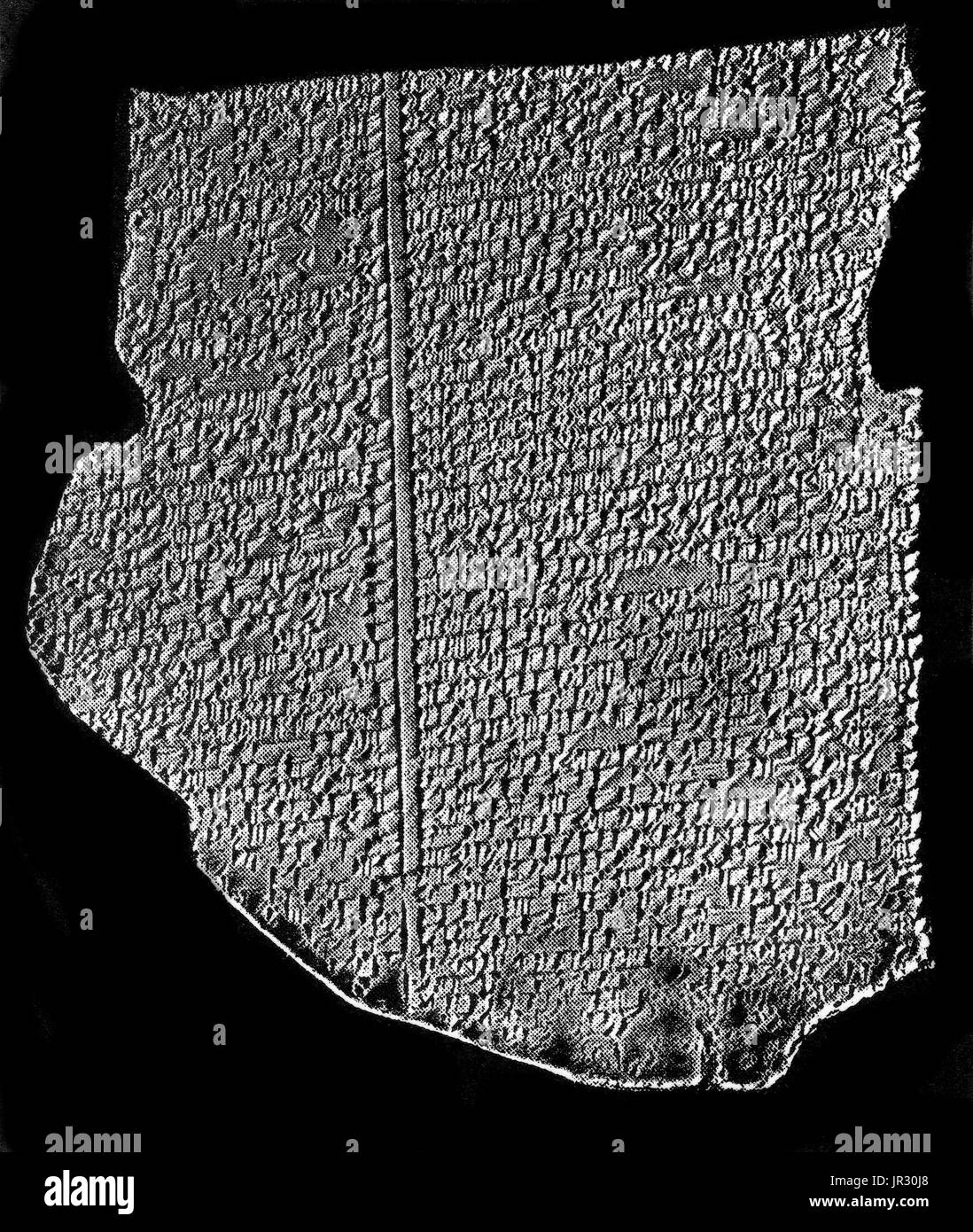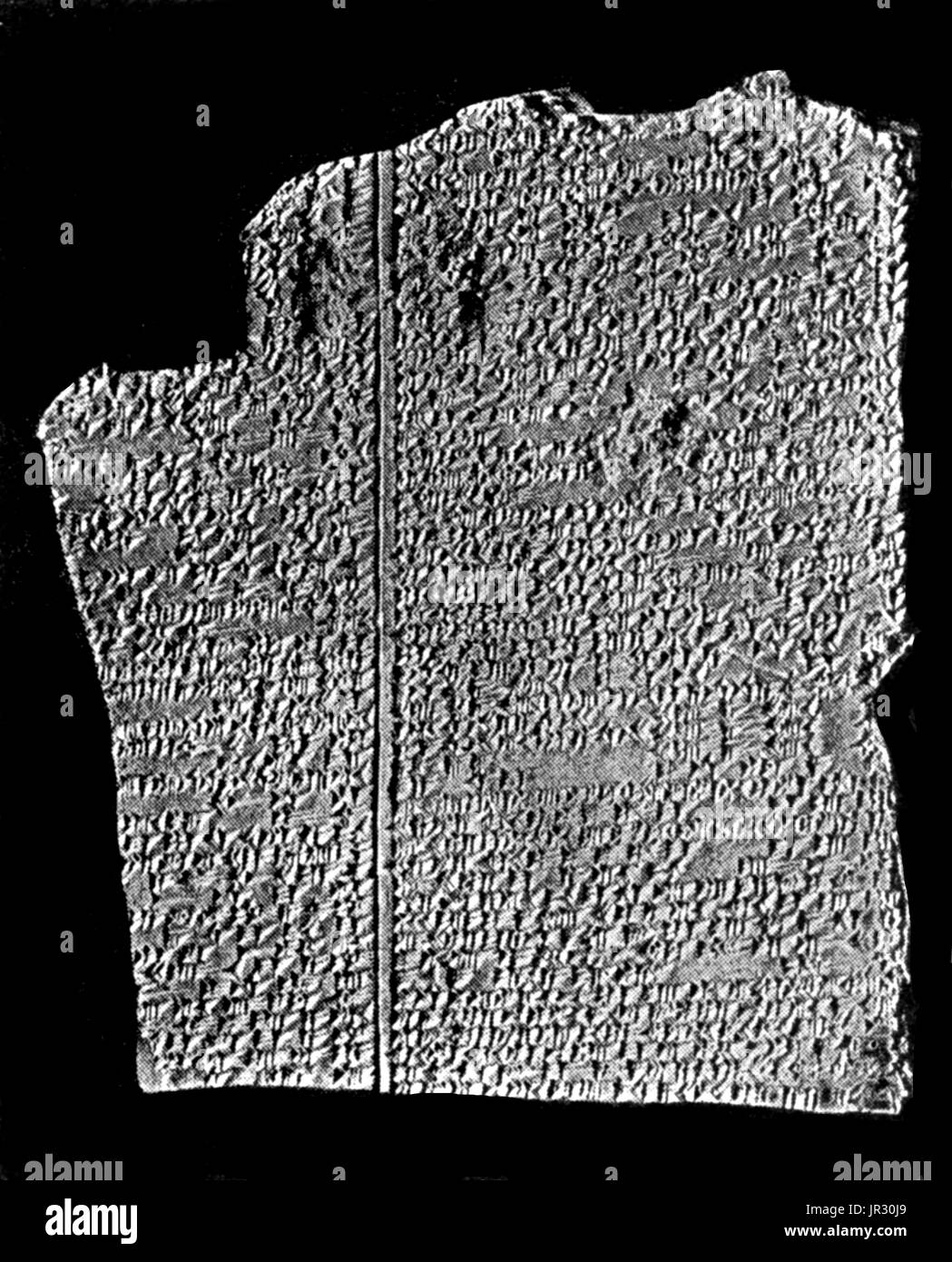Cuneiform writing Black & White Stock Photos
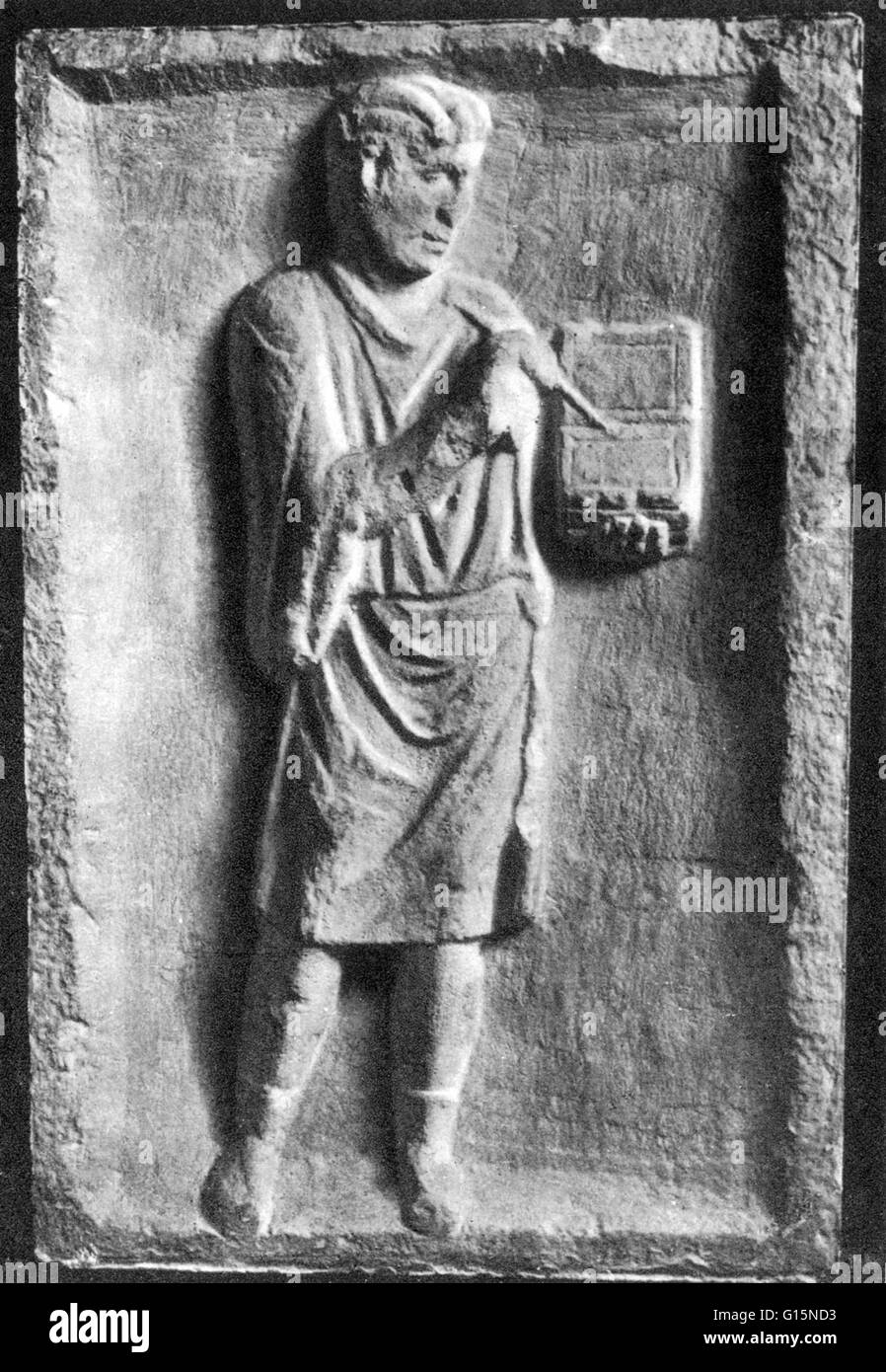 Roman scribe writing on wax tablets. A scribe is a person who writes books or documents by hand in hieroglyphics, cuneiform or other scripts and may help keep track of records for priests and government. The profession, previously found in all literate cu Stock Photohttps://www.alamy.com/image-license-details/?v=1https://www.alamy.com/stock-photo-roman-scribe-writing-on-wax-tablets-a-scribe-is-a-person-who-writes-104003455.html
Roman scribe writing on wax tablets. A scribe is a person who writes books or documents by hand in hieroglyphics, cuneiform or other scripts and may help keep track of records for priests and government. The profession, previously found in all literate cu Stock Photohttps://www.alamy.com/image-license-details/?v=1https://www.alamy.com/stock-photo-roman-scribe-writing-on-wax-tablets-a-scribe-is-a-person-who-writes-104003455.htmlRMG15ND3–Roman scribe writing on wax tablets. A scribe is a person who writes books or documents by hand in hieroglyphics, cuneiform or other scripts and may help keep track of records for priests and government. The profession, previously found in all literate cu
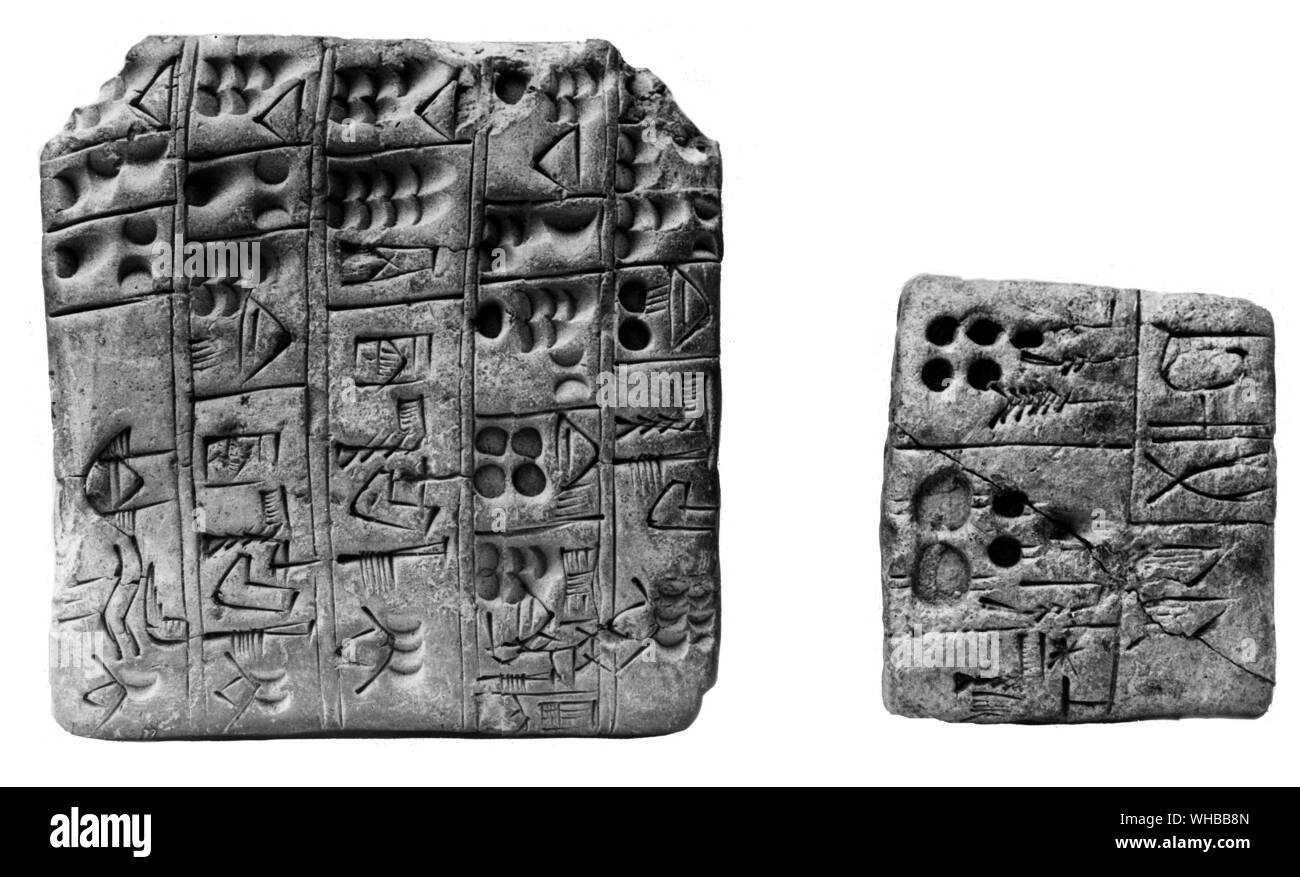 Cuneiform Writing : Early tablet showing archaic script Stock Photohttps://www.alamy.com/image-license-details/?v=1https://www.alamy.com/cuneiform-writing-early-tablet-showing-archaic-script-image268855013.html
Cuneiform Writing : Early tablet showing archaic script Stock Photohttps://www.alamy.com/image-license-details/?v=1https://www.alamy.com/cuneiform-writing-early-tablet-showing-archaic-script-image268855013.htmlRMWHBB8N–Cuneiform Writing : Early tablet showing archaic script
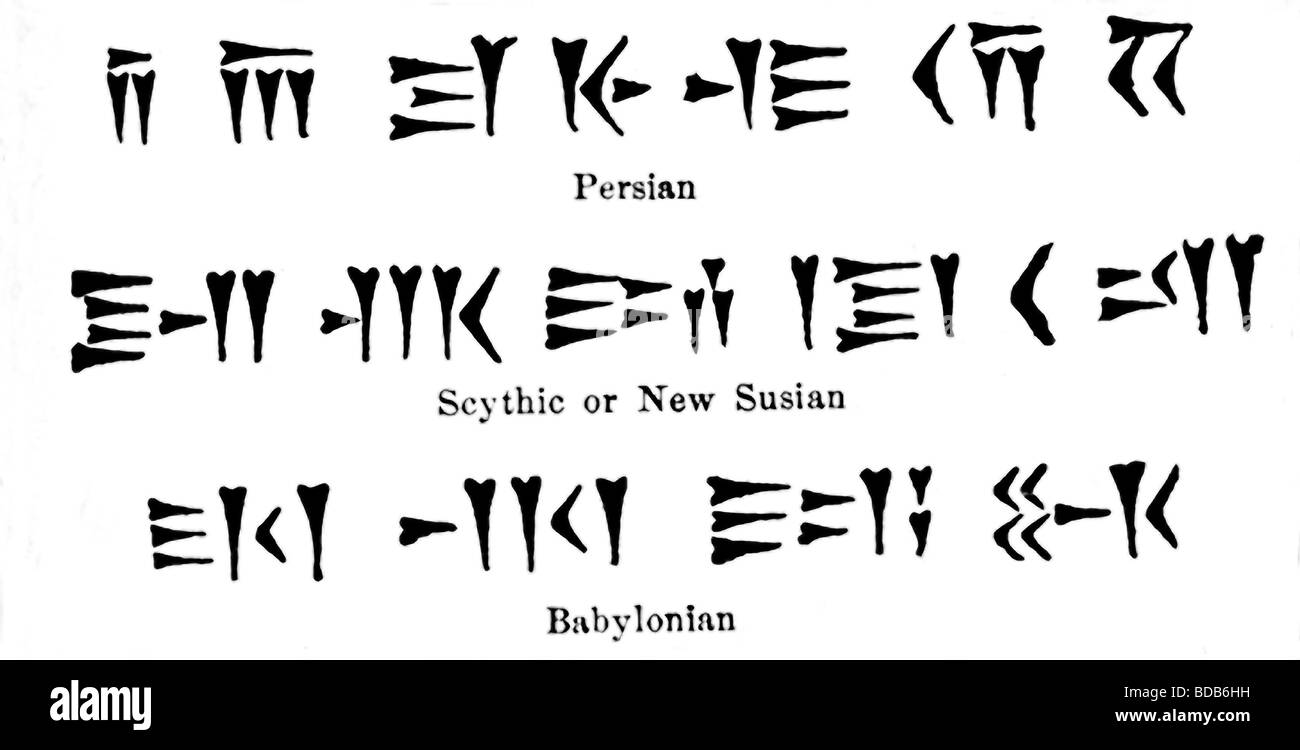 In this image is the name Darius written in cuneiform characters—in the Persian, Scythian, and Babylonian alphabets. Stock Photohttps://www.alamy.com/image-license-details/?v=1https://www.alamy.com/stock-photo-in-this-image-is-the-name-darius-written-in-cuneiform-charactersin-25447565.html
In this image is the name Darius written in cuneiform characters—in the Persian, Scythian, and Babylonian alphabets. Stock Photohttps://www.alamy.com/image-license-details/?v=1https://www.alamy.com/stock-photo-in-this-image-is-the-name-darius-written-in-cuneiform-charactersin-25447565.htmlRFBDB6HH–In this image is the name Darius written in cuneiform characters—in the Persian, Scythian, and Babylonian alphabets.
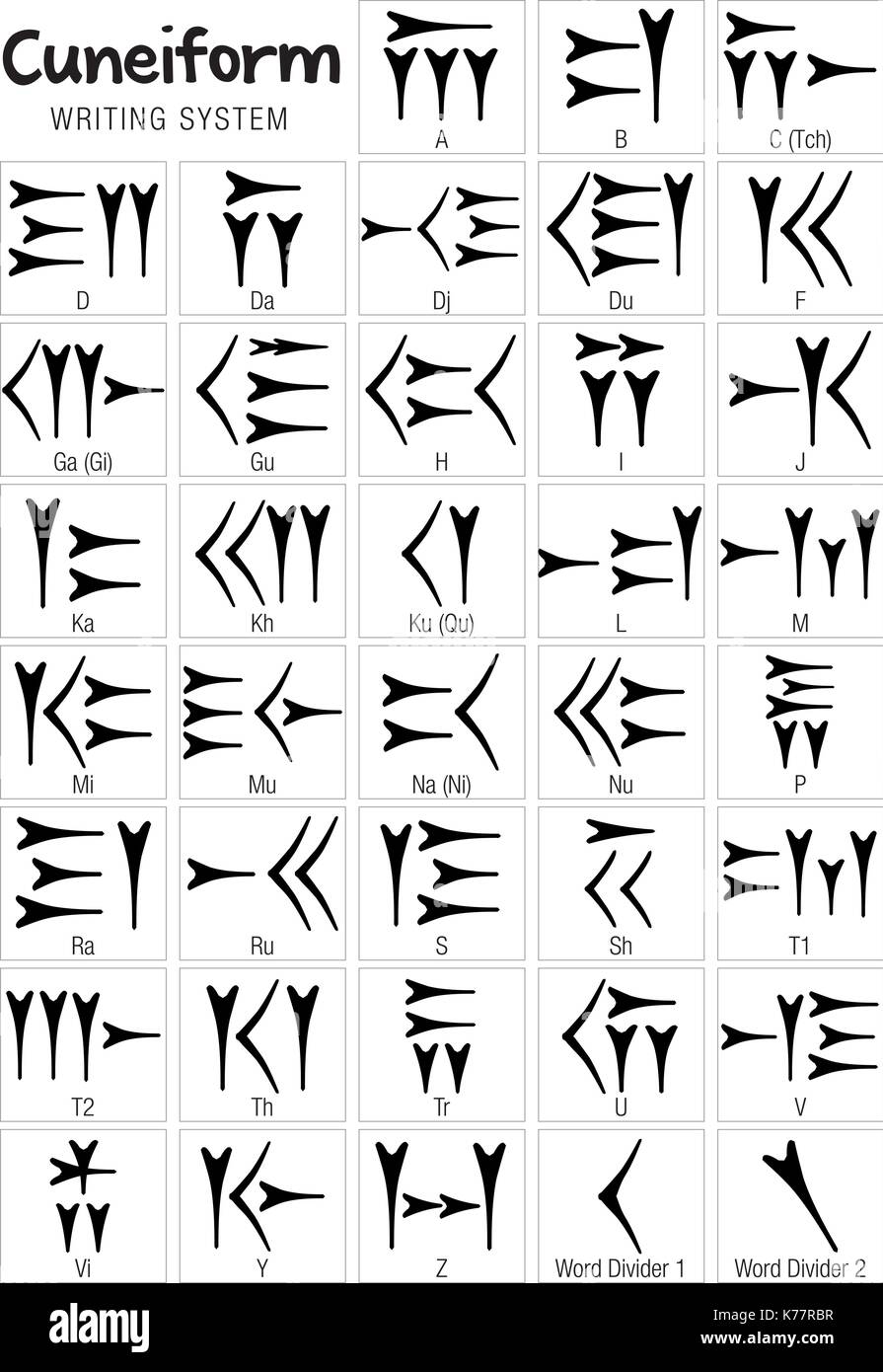 Cuneiform is a system of writing first developed by the ancient Sumerians of Mesopotamia Stock Vectorhttps://www.alamy.com/image-license-details/?v=1https://www.alamy.com/cuneiform-is-a-system-of-writing-first-developed-by-the-ancient-sumerians-image159367931.html
Cuneiform is a system of writing first developed by the ancient Sumerians of Mesopotamia Stock Vectorhttps://www.alamy.com/image-license-details/?v=1https://www.alamy.com/cuneiform-is-a-system-of-writing-first-developed-by-the-ancient-sumerians-image159367931.htmlRFK77RBR–Cuneiform is a system of writing first developed by the ancient Sumerians of Mesopotamia
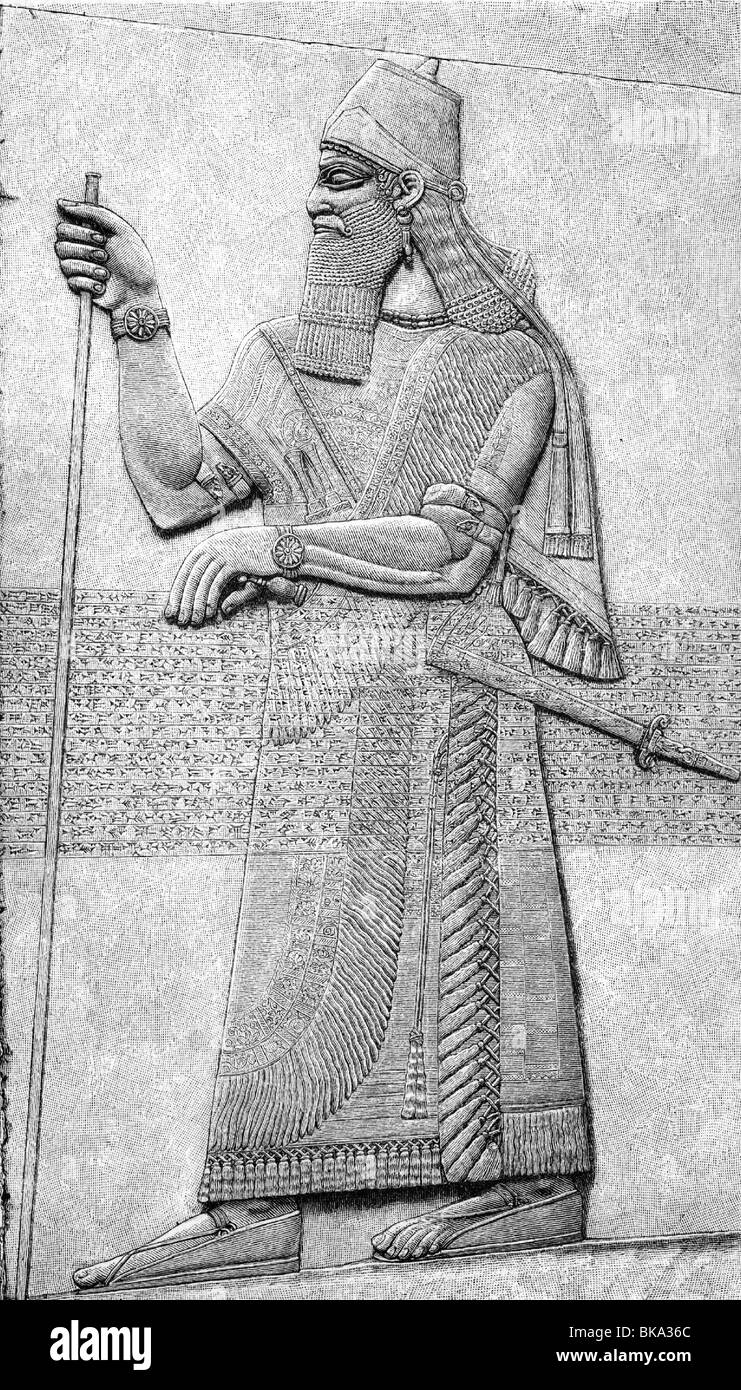 ancient world, Assyria, people, King Ashurnasirpal, relief from Nimrud, British Museum London, historic, historical, scripture, wedge writing, cuneiform writing, Assyrian, Assur, Assur-Nasir-Apli, ancient world, Stock Photohttps://www.alamy.com/image-license-details/?v=1https://www.alamy.com/stock-photo-ancient-world-assyria-people-king-ashurnasirpal-relief-from-nimrud-29110884.html
ancient world, Assyria, people, King Ashurnasirpal, relief from Nimrud, British Museum London, historic, historical, scripture, wedge writing, cuneiform writing, Assyrian, Assur, Assur-Nasir-Apli, ancient world, Stock Photohttps://www.alamy.com/image-license-details/?v=1https://www.alamy.com/stock-photo-ancient-world-assyria-people-king-ashurnasirpal-relief-from-nimrud-29110884.htmlRMBKA36C–ancient world, Assyria, people, King Ashurnasirpal, relief from Nimrud, British Museum London, historic, historical, scripture, wedge writing, cuneiform writing, Assyrian, Assur, Assur-Nasir-Apli, ancient world,
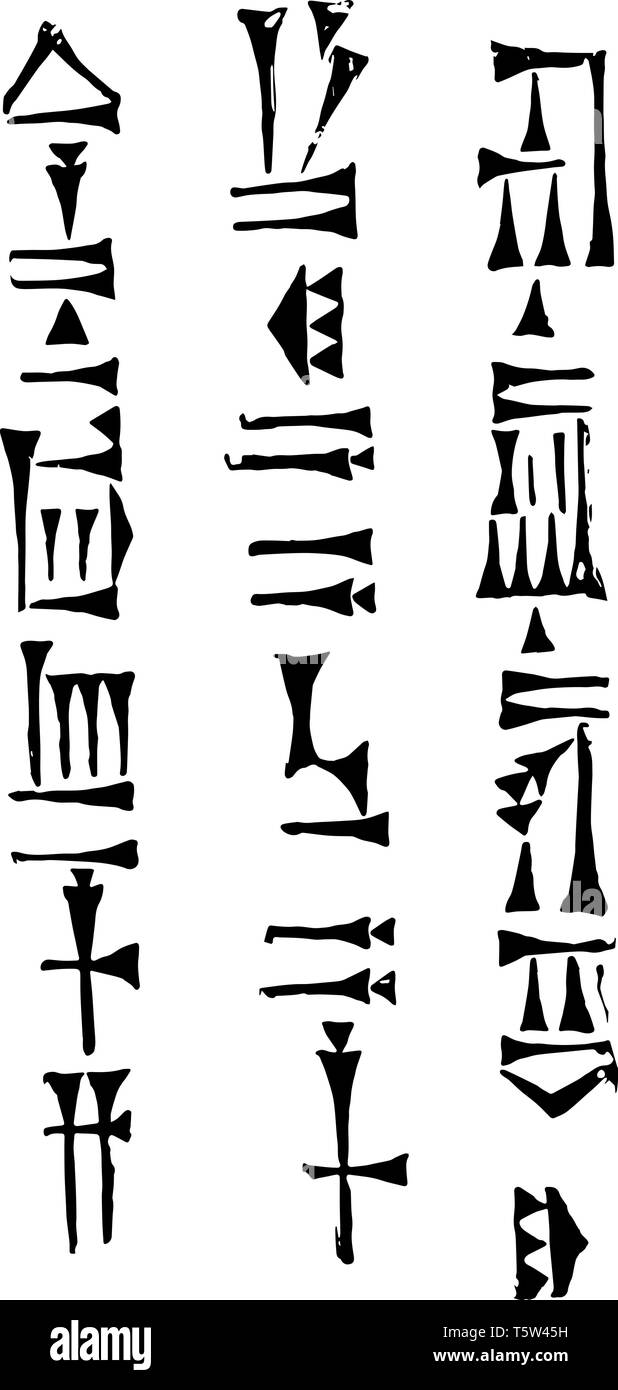 The sample of cuneiform writing of the ancient Sumerian or Assyrian civilization. This script is completely engraved on the stone, vintage line drawin Stock Vectorhttps://www.alamy.com/image-license-details/?v=1https://www.alamy.com/the-sample-of-cuneiform-writing-of-the-ancient-sumerian-or-assyrian-civilization-this-script-is-completely-engraved-on-the-stone-vintage-line-drawin-image244570525.html
The sample of cuneiform writing of the ancient Sumerian or Assyrian civilization. This script is completely engraved on the stone, vintage line drawin Stock Vectorhttps://www.alamy.com/image-license-details/?v=1https://www.alamy.com/the-sample-of-cuneiform-writing-of-the-ancient-sumerian-or-assyrian-civilization-this-script-is-completely-engraved-on-the-stone-vintage-line-drawin-image244570525.htmlRFT5W45H–The sample of cuneiform writing of the ancient Sumerian or Assyrian civilization. This script is completely engraved on the stone, vintage line drawin
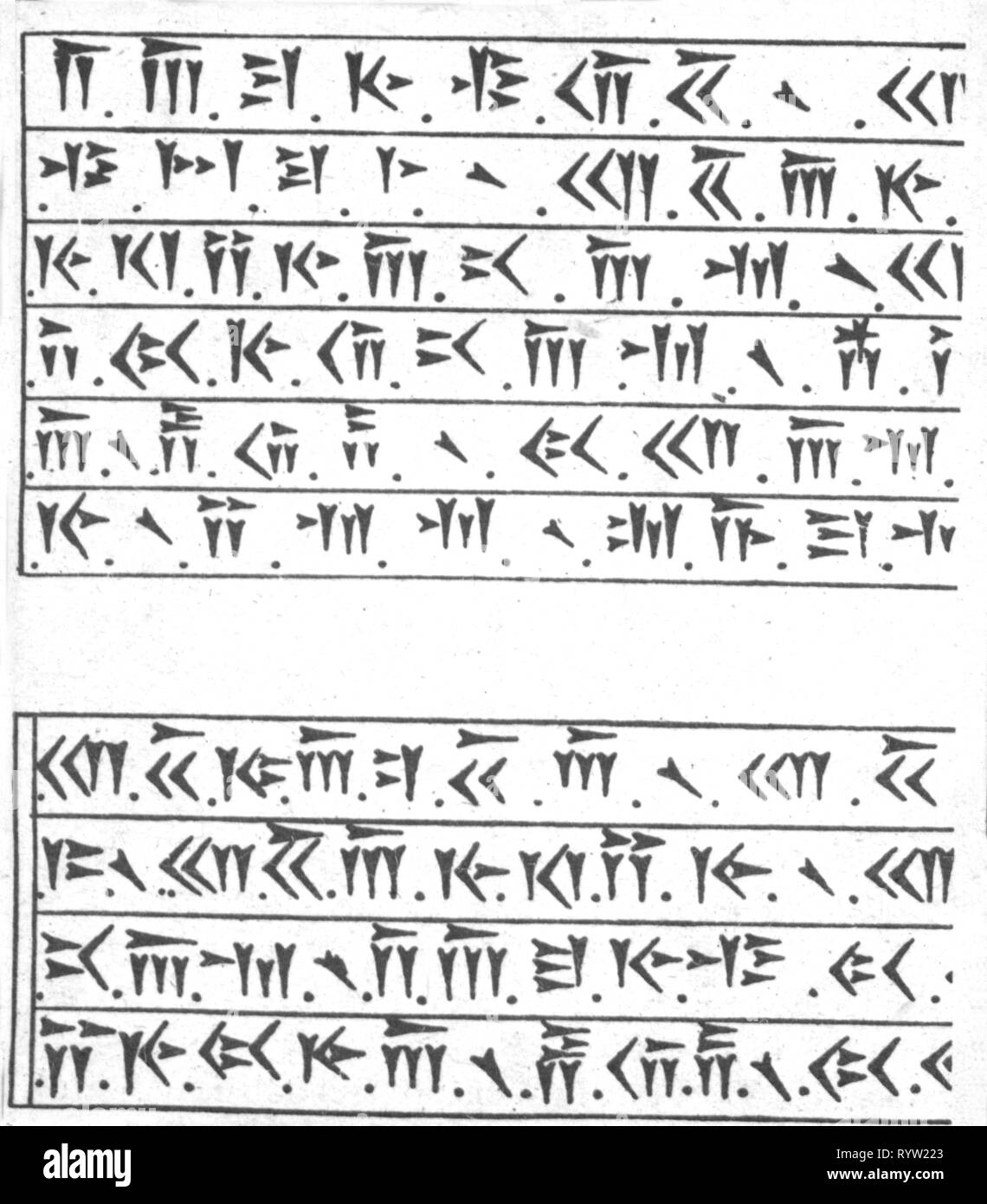 writing, script, cuneiform script, old Persian, cuneiform tablets G and B, illustration to 'Neue Beitraege zur Erlaeuterung der persepolitanischen Keilschrift' by Georg Friedrich Grotefend, 1837, Additional-Rights-Clearance-Info-Not-Available Stock Photohttps://www.alamy.com/image-license-details/?v=1https://www.alamy.com/writing-script-cuneiform-script-old-persian-cuneiform-tablets-g-and-b-illustration-to-neue-beitraege-zur-erlaeuterung-der-persepolitanischen-keilschrift-by-georg-friedrich-grotefend-1837-additional-rights-clearance-info-not-available-image240880923.html
writing, script, cuneiform script, old Persian, cuneiform tablets G and B, illustration to 'Neue Beitraege zur Erlaeuterung der persepolitanischen Keilschrift' by Georg Friedrich Grotefend, 1837, Additional-Rights-Clearance-Info-Not-Available Stock Photohttps://www.alamy.com/image-license-details/?v=1https://www.alamy.com/writing-script-cuneiform-script-old-persian-cuneiform-tablets-g-and-b-illustration-to-neue-beitraege-zur-erlaeuterung-der-persepolitanischen-keilschrift-by-georg-friedrich-grotefend-1837-additional-rights-clearance-info-not-available-image240880923.htmlRMRYW223–writing, script, cuneiform script, old Persian, cuneiform tablets G and B, illustration to 'Neue Beitraege zur Erlaeuterung der persepolitanischen Keilschrift' by Georg Friedrich Grotefend, 1837, Additional-Rights-Clearance-Info-Not-Available
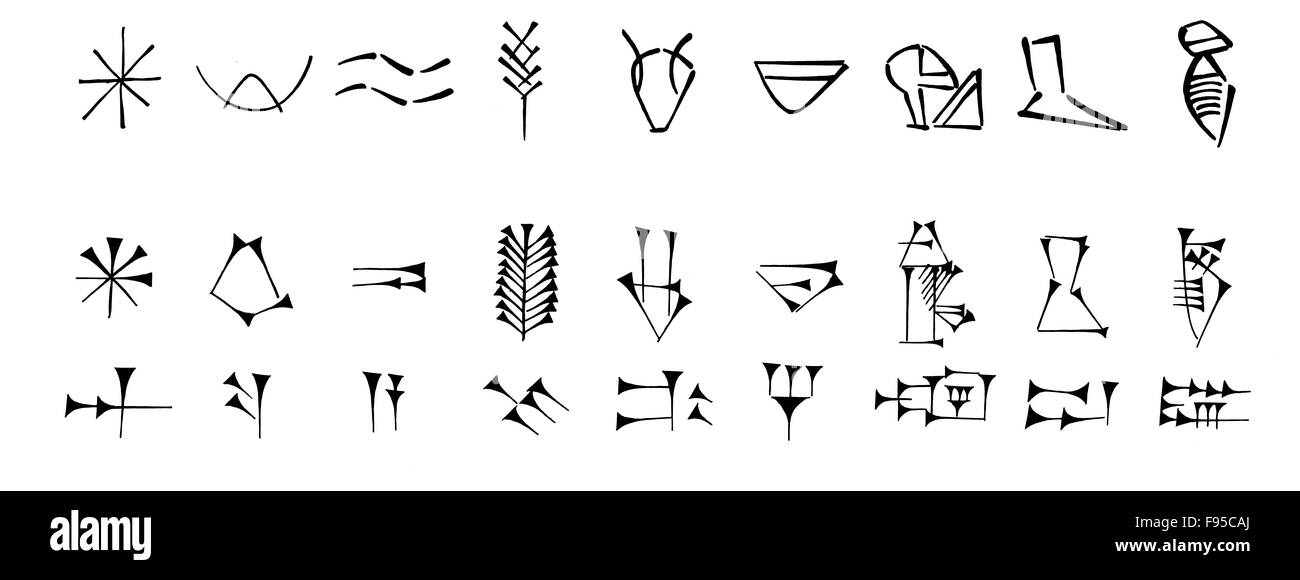 Development of the Cuneiform script. Stock Photohttps://www.alamy.com/image-license-details/?v=1https://www.alamy.com/stock-photo-development-of-the-cuneiform-script-91703210.html
Development of the Cuneiform script. Stock Photohttps://www.alamy.com/image-license-details/?v=1https://www.alamy.com/stock-photo-development-of-the-cuneiform-script-91703210.htmlRMF95CAJ–Development of the Cuneiform script.
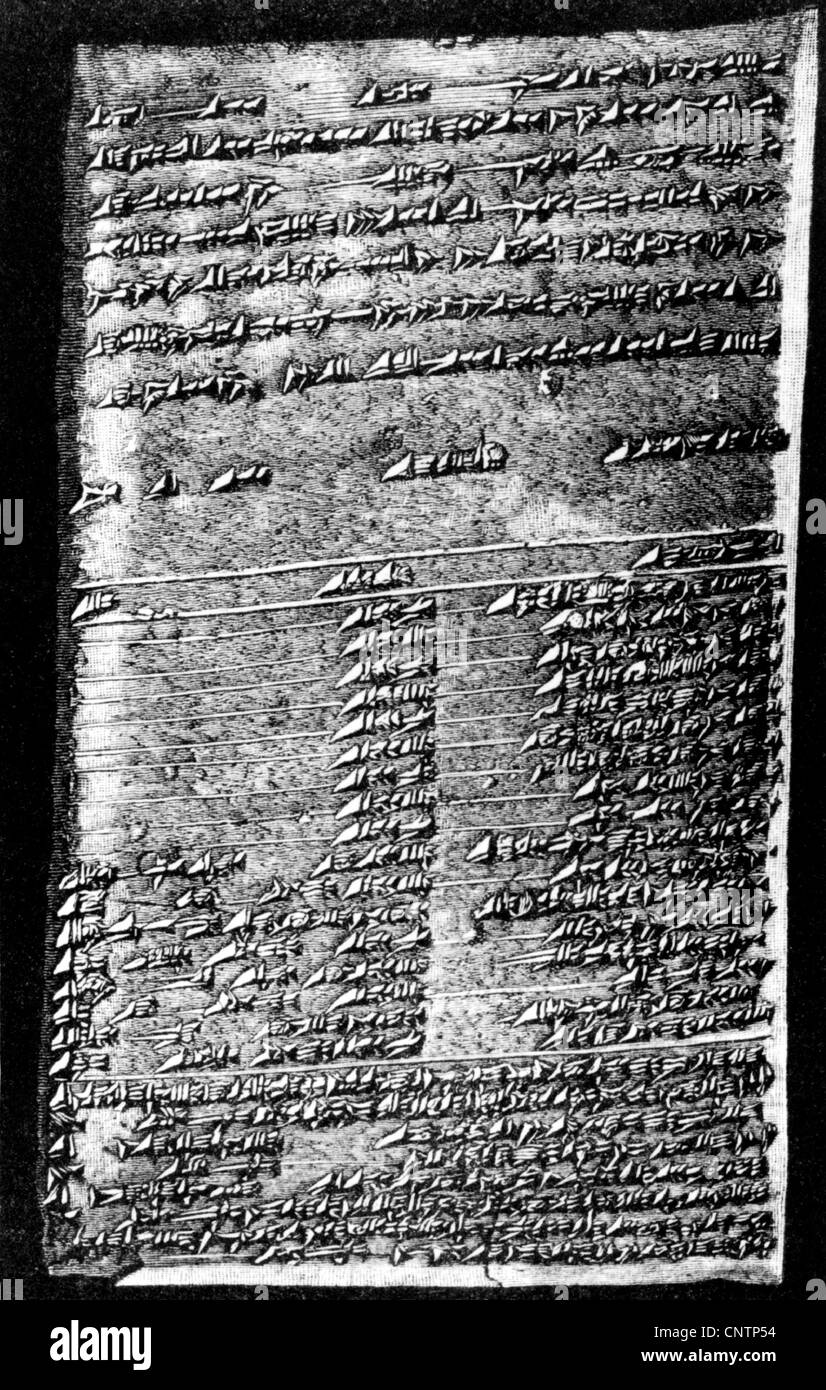 writing, Cuneiform script, Assur, tablet from the archive of Ashurbanipal (1050 - 1032 BC), scripts, Mesopotamia, Assyria, Assyrian, historic, historical, ancient world, Additional-Rights-Clearences-Not Available Stock Photohttps://www.alamy.com/image-license-details/?v=1https://www.alamy.com/stock-photo-writing-cuneiform-script-assur-tablet-from-the-archive-of-ashurbanipal-47872752.html
writing, Cuneiform script, Assur, tablet from the archive of Ashurbanipal (1050 - 1032 BC), scripts, Mesopotamia, Assyria, Assyrian, historic, historical, ancient world, Additional-Rights-Clearences-Not Available Stock Photohttps://www.alamy.com/image-license-details/?v=1https://www.alamy.com/stock-photo-writing-cuneiform-script-assur-tablet-from-the-archive-of-ashurbanipal-47872752.htmlRMCNTP54–writing, Cuneiform script, Assur, tablet from the archive of Ashurbanipal (1050 - 1032 BC), scripts, Mesopotamia, Assyria, Assyrian, historic, historical, ancient world, Additional-Rights-Clearences-Not Available
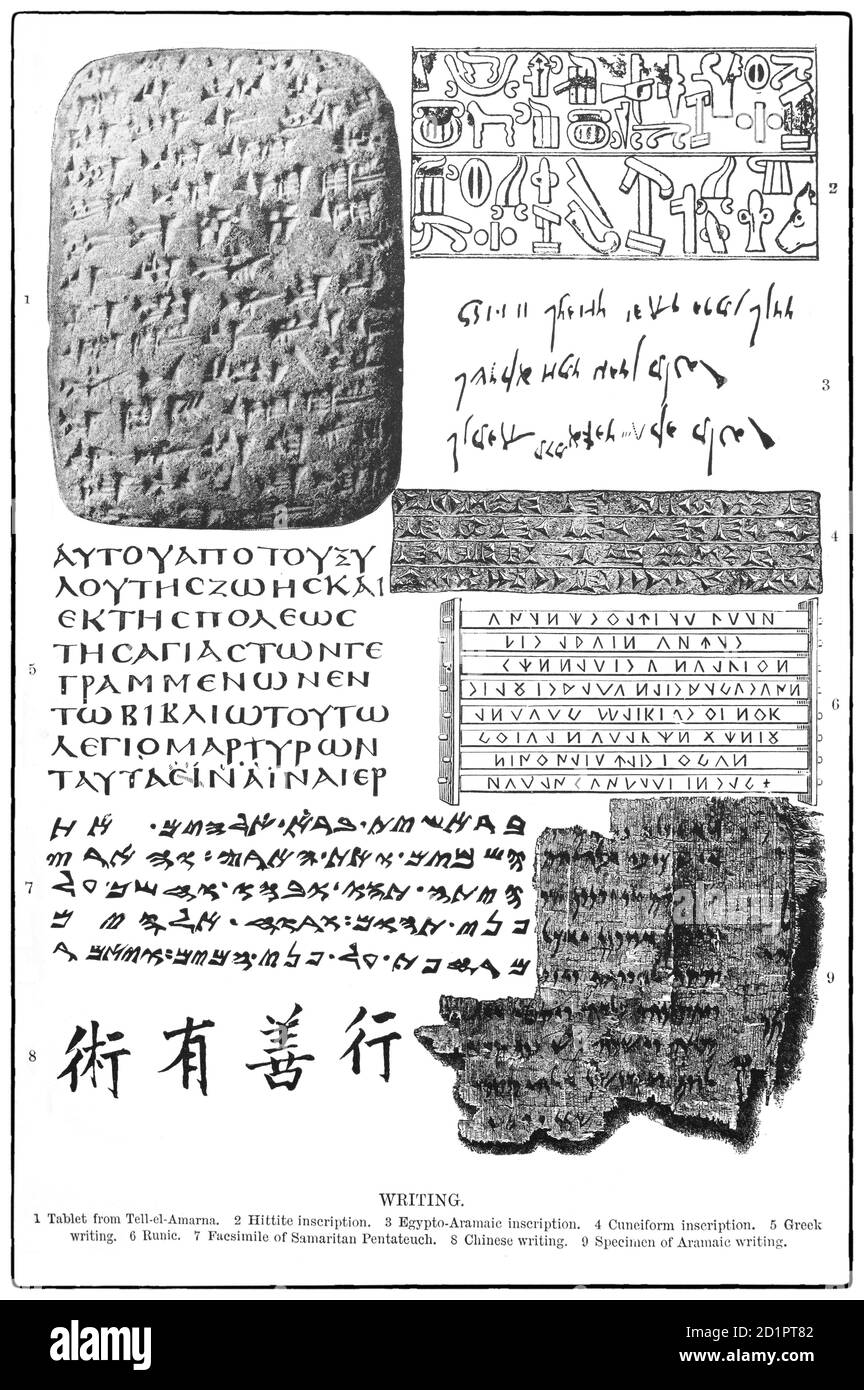 A late 19th Century chart illustrating various types of historic writing. Writing was thought to have been invented in a single civilization, a theory named 'monogenesis'and originated in ancient Sumer (in Mesopotamia) and spread over the world from there via a process of cultural diffusion. According to this theory, the concept of representing language by written marks, though not necessarily the specifics of how such a system worked, was passed on by traders or merchants traveling between geographical regions Stock Photohttps://www.alamy.com/image-license-details/?v=1https://www.alamy.com/a-late-19th-century-chart-illustrating-various-types-of-historic-writing-writing-was-thought-to-have-been-invented-in-a-single-civilization-a-theory-named-monogenesisand-originated-in-ancient-sumer-in-mesopotamia-and-spread-over-the-world-from-there-via-a-process-of-cultural-diffusion-according-to-this-theory-the-concept-of-representing-language-by-written-marks-though-not-necessarily-the-specifics-of-how-such-a-system-worked-was-passed-on-by-traders-or-merchants-traveling-between-geographical-regions-image379744738.html
A late 19th Century chart illustrating various types of historic writing. Writing was thought to have been invented in a single civilization, a theory named 'monogenesis'and originated in ancient Sumer (in Mesopotamia) and spread over the world from there via a process of cultural diffusion. According to this theory, the concept of representing language by written marks, though not necessarily the specifics of how such a system worked, was passed on by traders or merchants traveling between geographical regions Stock Photohttps://www.alamy.com/image-license-details/?v=1https://www.alamy.com/a-late-19th-century-chart-illustrating-various-types-of-historic-writing-writing-was-thought-to-have-been-invented-in-a-single-civilization-a-theory-named-monogenesisand-originated-in-ancient-sumer-in-mesopotamia-and-spread-over-the-world-from-there-via-a-process-of-cultural-diffusion-according-to-this-theory-the-concept-of-representing-language-by-written-marks-though-not-necessarily-the-specifics-of-how-such-a-system-worked-was-passed-on-by-traders-or-merchants-traveling-between-geographical-regions-image379744738.htmlRM2D1PT82–A late 19th Century chart illustrating various types of historic writing. Writing was thought to have been invented in a single civilization, a theory named 'monogenesis'and originated in ancient Sumer (in Mesopotamia) and spread over the world from there via a process of cultural diffusion. According to this theory, the concept of representing language by written marks, though not necessarily the specifics of how such a system worked, was passed on by traders or merchants traveling between geographical regions
 Cuneiform tablet from Umma, Iraq. Around 2030 BC. Musée national d'archéologie, d'histoire et d'art (MNAHA) in Luxembourg. Stock Photohttps://www.alamy.com/image-license-details/?v=1https://www.alamy.com/cuneiform-tablet-from-umma-iraq-around-2030-bc-muse-national-darchologie-dhistoire-et-dart-mnaha-in-luxembourg-image568463457.html
Cuneiform tablet from Umma, Iraq. Around 2030 BC. Musée national d'archéologie, d'histoire et d'art (MNAHA) in Luxembourg. Stock Photohttps://www.alamy.com/image-license-details/?v=1https://www.alamy.com/cuneiform-tablet-from-umma-iraq-around-2030-bc-muse-national-darchologie-dhistoire-et-dart-mnaha-in-luxembourg-image568463457.htmlRM2T0RMX9–Cuneiform tablet from Umma, Iraq. Around 2030 BC. Musée national d'archéologie, d'histoire et d'art (MNAHA) in Luxembourg.
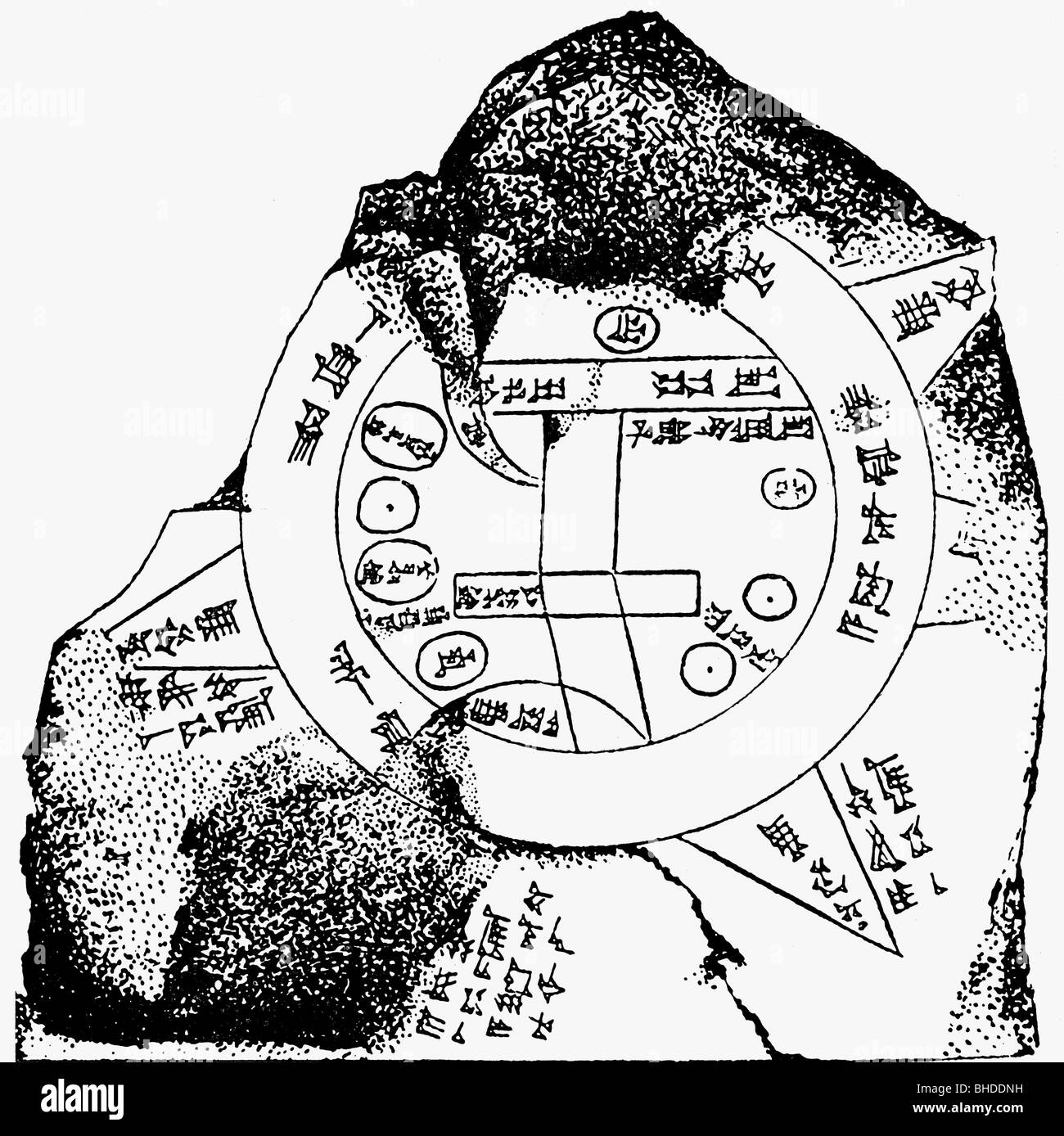 cartography, world maps, Babylonian map, Sippar, circa 600 BC, British Museum, London, wood engraving, 19th century, earth, map, disc, ocean, ancient world, antiquity, Babylon, Mesopotamia, cuneiform script, writing, historic, historical, ancient world, Stock Photohttps://www.alamy.com/image-license-details/?v=1https://www.alamy.com/stock-photo-cartography-world-maps-babylonian-map-sippar-circa-600-bc-british-27955693.html
cartography, world maps, Babylonian map, Sippar, circa 600 BC, British Museum, London, wood engraving, 19th century, earth, map, disc, ocean, ancient world, antiquity, Babylon, Mesopotamia, cuneiform script, writing, historic, historical, ancient world, Stock Photohttps://www.alamy.com/image-license-details/?v=1https://www.alamy.com/stock-photo-cartography-world-maps-babylonian-map-sippar-circa-600-bc-british-27955693.htmlRMBHDDNH–cartography, world maps, Babylonian map, Sippar, circa 600 BC, British Museum, London, wood engraving, 19th century, earth, map, disc, ocean, ancient world, antiquity, Babylon, Mesopotamia, cuneiform script, writing, historic, historical, ancient world,
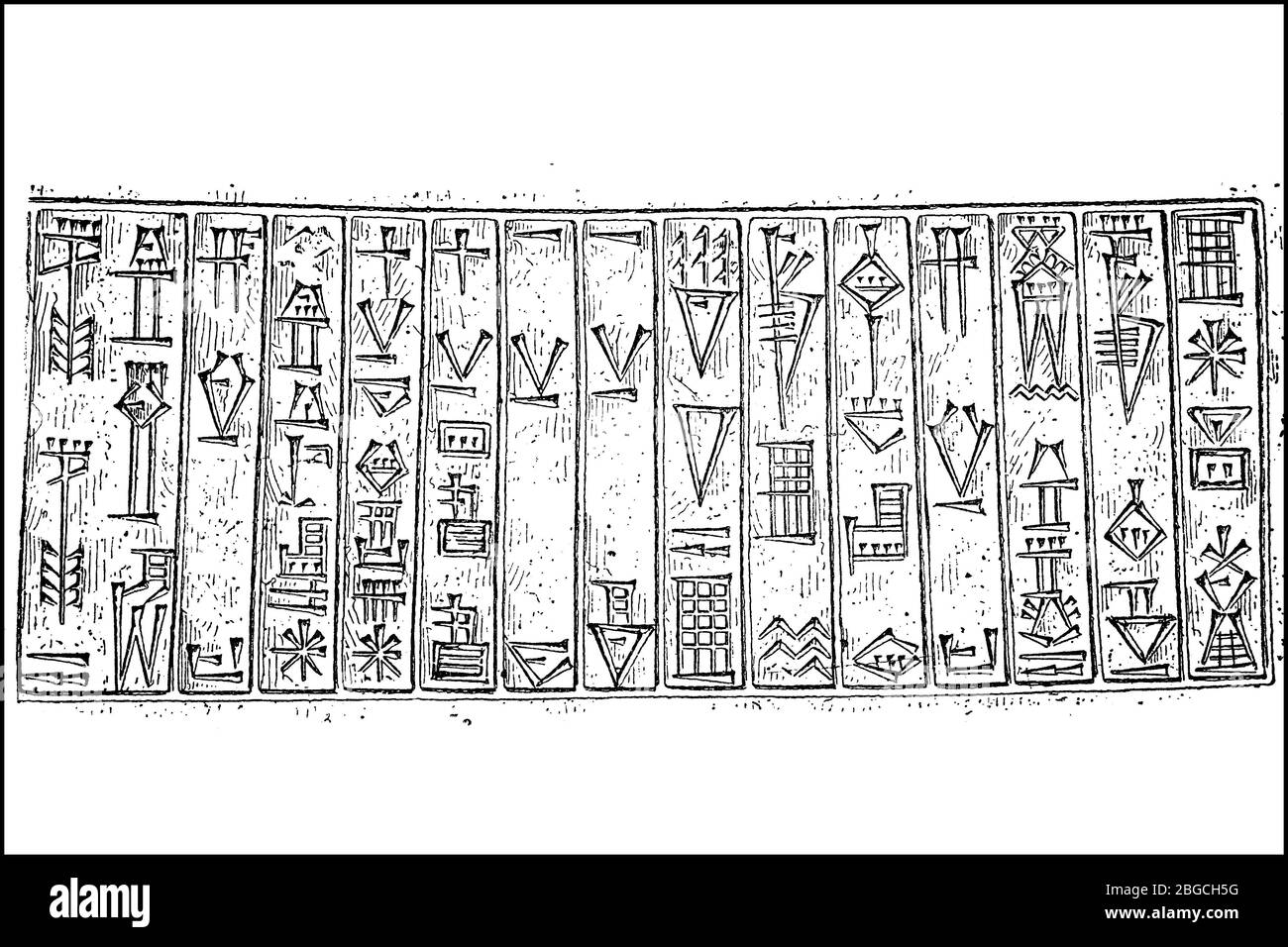 Fragment of the inscription on a statue of Tello, as an example of the older line arrangement, hieroglyphics, pictographic writing, cuneiform / Bruchstueck der Inschrift auf einer Statue von Tello, als Beispiel fuer die aeltere Zeilenanordnung, Hieroglyphen, Bilderschrift, Keilschrift, Historisch, historical, digital improved reproduction of an original from the 19th century / digitale Reproduktion einer Originalvorlage aus dem 19. Jahrhundert Stock Photohttps://www.alamy.com/image-license-details/?v=1https://www.alamy.com/fragment-of-the-inscription-on-a-statue-of-tello-as-an-example-of-the-older-line-arrangement-hieroglyphics-pictographic-writing-cuneiform-bruchstueck-der-inschrift-auf-einer-statue-von-tello-als-beispiel-fuer-die-aeltere-zeilenanordnung-hieroglyphen-bilderschrift-keilschrift-historisch-historical-digital-improved-reproduction-of-an-original-from-the-19th-century-digitale-reproduktion-einer-originalvorlage-aus-dem-19-jahrhundert-image354318764.html
Fragment of the inscription on a statue of Tello, as an example of the older line arrangement, hieroglyphics, pictographic writing, cuneiform / Bruchstueck der Inschrift auf einer Statue von Tello, als Beispiel fuer die aeltere Zeilenanordnung, Hieroglyphen, Bilderschrift, Keilschrift, Historisch, historical, digital improved reproduction of an original from the 19th century / digitale Reproduktion einer Originalvorlage aus dem 19. Jahrhundert Stock Photohttps://www.alamy.com/image-license-details/?v=1https://www.alamy.com/fragment-of-the-inscription-on-a-statue-of-tello-as-an-example-of-the-older-line-arrangement-hieroglyphics-pictographic-writing-cuneiform-bruchstueck-der-inschrift-auf-einer-statue-von-tello-als-beispiel-fuer-die-aeltere-zeilenanordnung-hieroglyphen-bilderschrift-keilschrift-historisch-historical-digital-improved-reproduction-of-an-original-from-the-19th-century-digitale-reproduktion-einer-originalvorlage-aus-dem-19-jahrhundert-image354318764.htmlRF2BGCH5G–Fragment of the inscription on a statue of Tello, as an example of the older line arrangement, hieroglyphics, pictographic writing, cuneiform / Bruchstueck der Inschrift auf einer Statue von Tello, als Beispiel fuer die aeltere Zeilenanordnung, Hieroglyphen, Bilderschrift, Keilschrift, Historisch, historical, digital improved reproduction of an original from the 19th century / digitale Reproduktion einer Originalvorlage aus dem 19. Jahrhundert
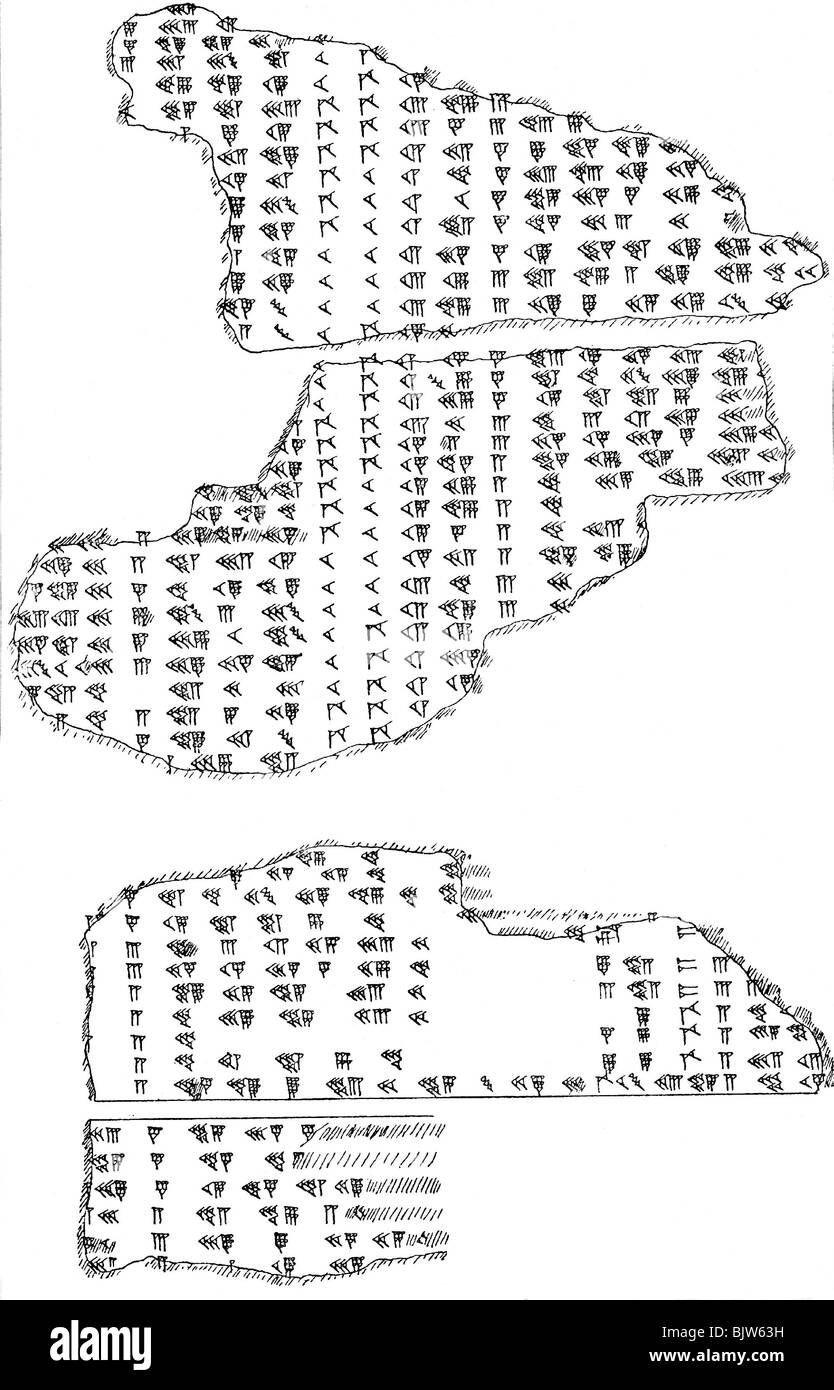 astronomy, ancient world, Babylon, charts with phases of the moon in wedge writing, fragments after Kugler 'The Babylonian moon calculation', 1900, wood engraving, Stock Photohttps://www.alamy.com/image-license-details/?v=1https://www.alamy.com/stock-photo-astronomy-ancient-world-babylon-charts-with-phases-of-the-moon-in-28827781.html
astronomy, ancient world, Babylon, charts with phases of the moon in wedge writing, fragments after Kugler 'The Babylonian moon calculation', 1900, wood engraving, Stock Photohttps://www.alamy.com/image-license-details/?v=1https://www.alamy.com/stock-photo-astronomy-ancient-world-babylon-charts-with-phases-of-the-moon-in-28827781.htmlRMBJW63H–astronomy, ancient world, Babylon, charts with phases of the moon in wedge writing, fragments after Kugler 'The Babylonian moon calculation', 1900, wood engraving,
 Assyrian Inscription Stock Photohttps://www.alamy.com/image-license-details/?v=1https://www.alamy.com/assyrian-inscription-image8245835.html
Assyrian Inscription Stock Photohttps://www.alamy.com/image-license-details/?v=1https://www.alamy.com/assyrian-inscription-image8245835.htmlRMAHCDTC–Assyrian Inscription
 Oldest picture forms of the cuneiform signs and their meaning (Bruchstück eines Tontäfelchens mit den ältesten Bilderformen der Keilschriftzeichen und ihre Bedeutung. Nach Hommel) Stock Photohttps://www.alamy.com/image-license-details/?v=1https://www.alamy.com/stock-image-oldest-picture-forms-of-the-cuneiform-signs-and-their-meaning-bruchstck-166099646.html
Oldest picture forms of the cuneiform signs and their meaning (Bruchstück eines Tontäfelchens mit den ältesten Bilderformen der Keilschriftzeichen und ihre Bedeutung. Nach Hommel) Stock Photohttps://www.alamy.com/image-license-details/?v=1https://www.alamy.com/stock-image-oldest-picture-forms-of-the-cuneiform-signs-and-their-meaning-bruchstck-166099646.htmlRMKJ6DP6–Oldest picture forms of the cuneiform signs and their meaning (Bruchstück eines Tontäfelchens mit den ältesten Bilderformen der Keilschriftzeichen und ihre Bedeutung. Nach Hommel)
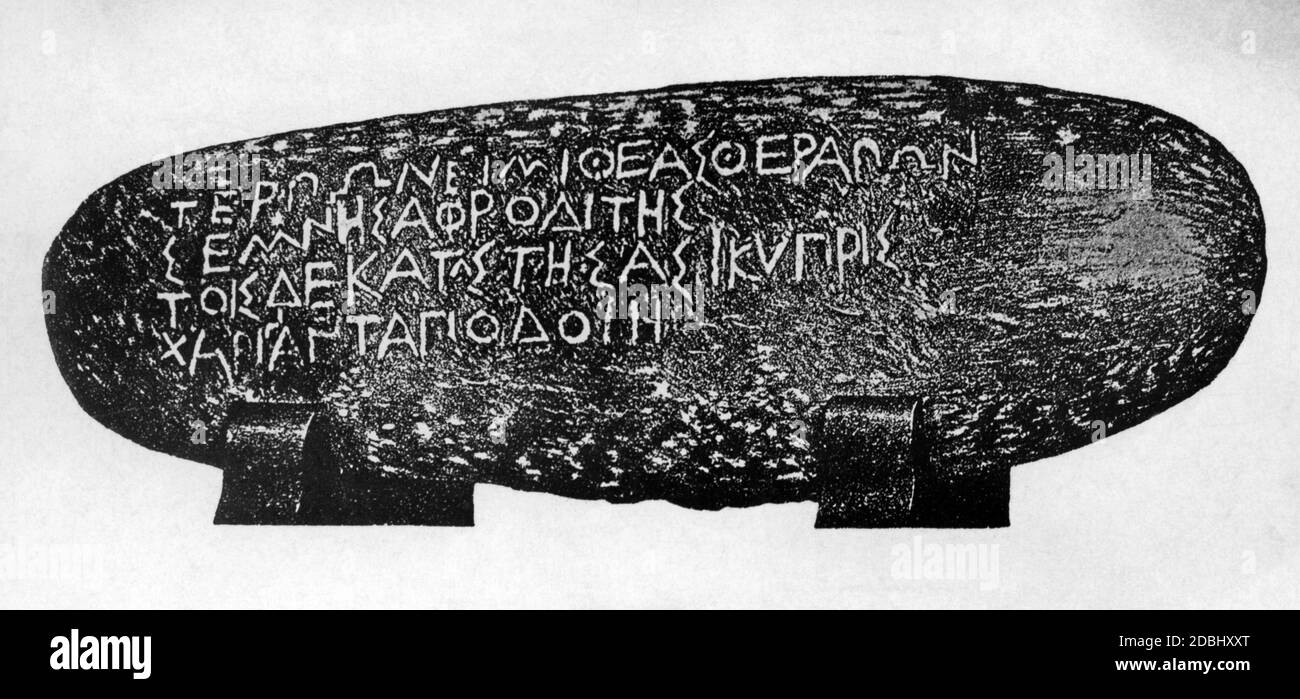 The Greek capitalis, or capitals, is a majuscule script, i.e. a form of writing using capital letters, suitable for writing on stone. This script was adopted by the Romans in the 7th century BC. From the 14th century onwards, it was associated with the humanist minuscule, a handwritten book script, and is the basis of the later antiqua typeface. Undated photo. Stock Photohttps://www.alamy.com/image-license-details/?v=1https://www.alamy.com/the-greek-capitalis-or-capitals-is-a-majuscule-script-ie-a-form-of-writing-using-capital-letters-suitable-for-writing-on-stone-this-script-was-adopted-by-the-romans-in-the-7th-century-bc-from-the-14th-century-onwards-it-was-associated-with-the-humanist-minuscule-a-handwritten-book-script-and-is-the-basis-of-the-later-antiqua-typeface-undated-photo-image385783632.html
The Greek capitalis, or capitals, is a majuscule script, i.e. a form of writing using capital letters, suitable for writing on stone. This script was adopted by the Romans in the 7th century BC. From the 14th century onwards, it was associated with the humanist minuscule, a handwritten book script, and is the basis of the later antiqua typeface. Undated photo. Stock Photohttps://www.alamy.com/image-license-details/?v=1https://www.alamy.com/the-greek-capitalis-or-capitals-is-a-majuscule-script-ie-a-form-of-writing-using-capital-letters-suitable-for-writing-on-stone-this-script-was-adopted-by-the-romans-in-the-7th-century-bc-from-the-14th-century-onwards-it-was-associated-with-the-humanist-minuscule-a-handwritten-book-script-and-is-the-basis-of-the-later-antiqua-typeface-undated-photo-image385783632.htmlRM2DBHXXT–The Greek capitalis, or capitals, is a majuscule script, i.e. a form of writing using capital letters, suitable for writing on stone. This script was adopted by the Romans in the 7th century BC. From the 14th century onwards, it was associated with the humanist minuscule, a handwritten book script, and is the basis of the later antiqua typeface. Undated photo.
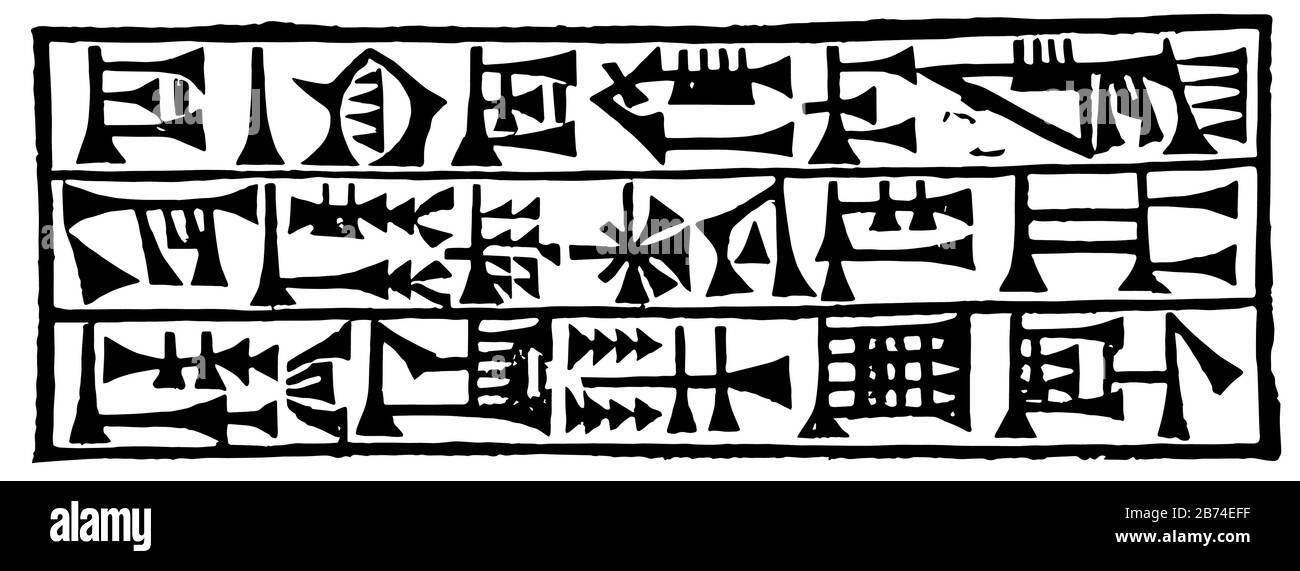 Cuneform Writing or wedge, wedge-shaped stylus, vintage line drawing or engraving illustration. Stock Vectorhttps://www.alamy.com/image-license-details/?v=1https://www.alamy.com/cuneform-writing-or-wedge-wedge-shaped-stylus-vintage-line-drawing-or-engraving-illustration-image348609171.html
Cuneform Writing or wedge, wedge-shaped stylus, vintage line drawing or engraving illustration. Stock Vectorhttps://www.alamy.com/image-license-details/?v=1https://www.alamy.com/cuneform-writing-or-wedge-wedge-shaped-stylus-vintage-line-drawing-or-engraving-illustration-image348609171.htmlRF2B74EFF–Cuneform Writing or wedge, wedge-shaped stylus, vintage line drawing or engraving illustration.
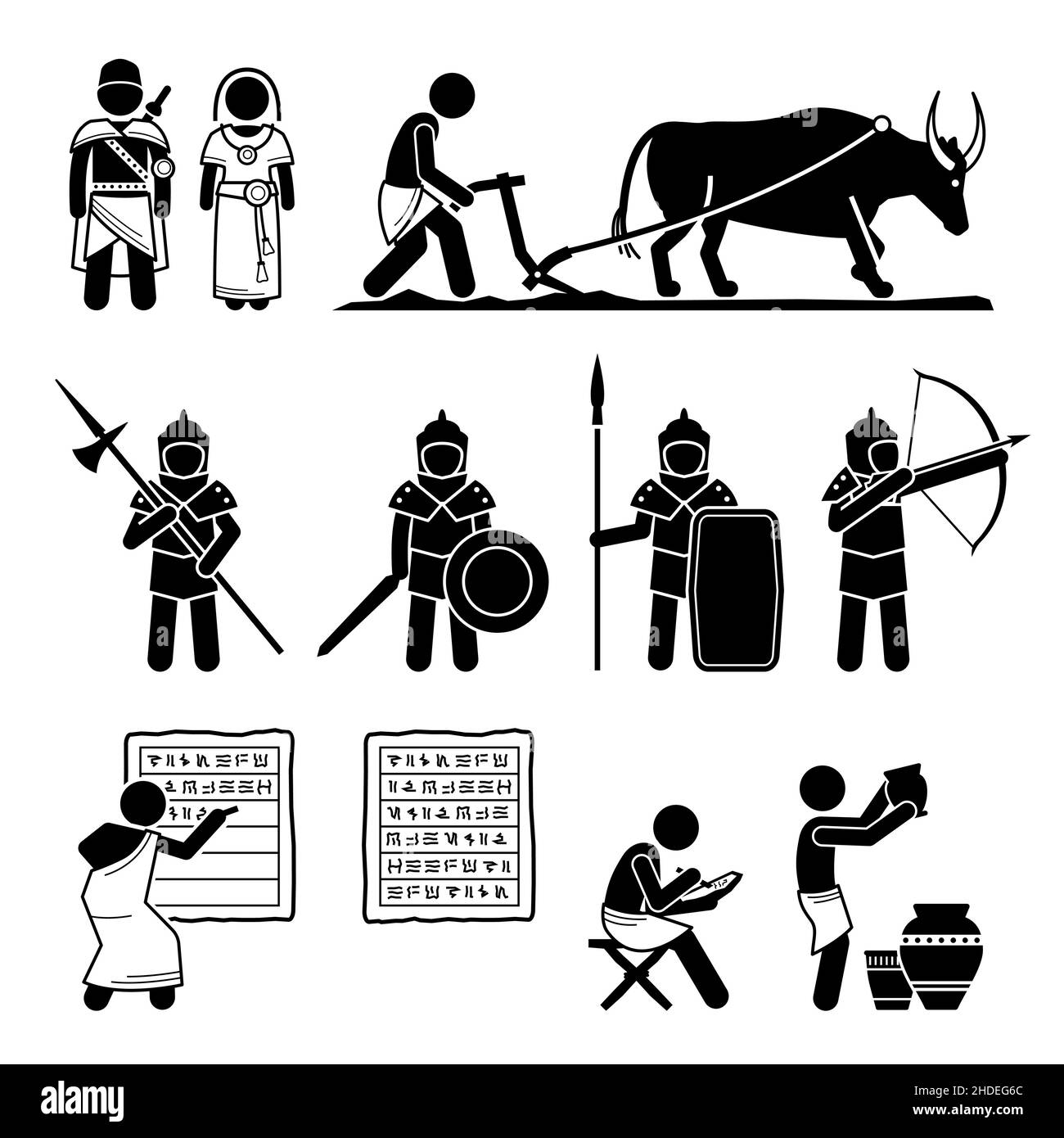 Ancient History Bronze Age Medieval Human Civilization in Middle Age. Vector illustrations depict human technology development during the bronze age a Stock Vectorhttps://www.alamy.com/image-license-details/?v=1https://www.alamy.com/ancient-history-bronze-age-medieval-human-civilization-in-middle-age-vector-illustrations-depict-human-technology-development-during-the-bronze-age-a-image455780148.html
Ancient History Bronze Age Medieval Human Civilization in Middle Age. Vector illustrations depict human technology development during the bronze age a Stock Vectorhttps://www.alamy.com/image-license-details/?v=1https://www.alamy.com/ancient-history-bronze-age-medieval-human-civilization-in-middle-age-vector-illustrations-depict-human-technology-development-during-the-bronze-age-a-image455780148.htmlRF2HDEG6C–Ancient History Bronze Age Medieval Human Civilization in Middle Age. Vector illustrations depict human technology development during the bronze age a
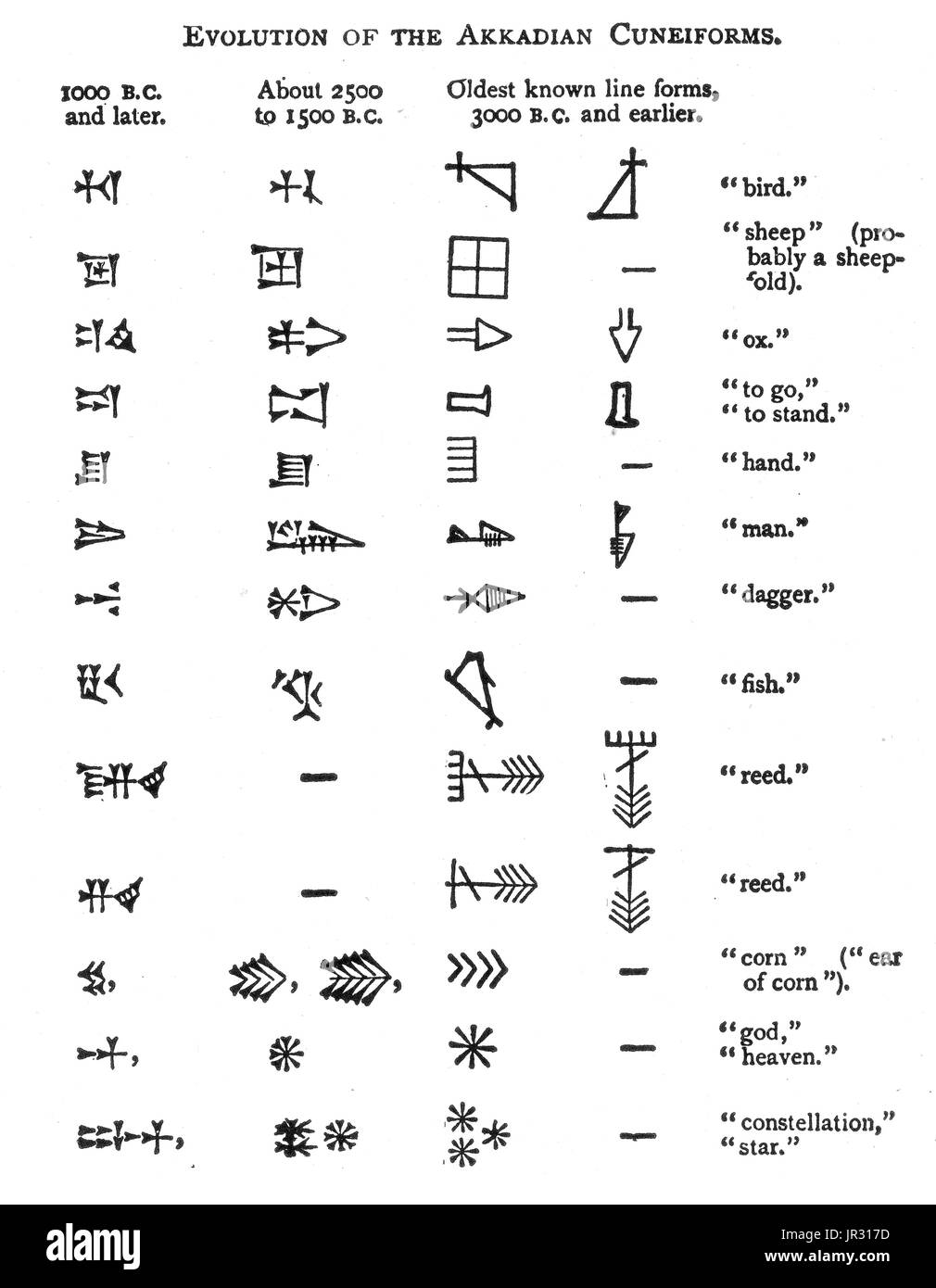 Akkadian is an extinct East Semitic language that was spoken in ancient Mesopotamia. The earliest attested Semitic language, it used the cuneiform writing system, which was originally used to write the unrelated Ancient Sumerian, a language isolate. The language was named after the city of Akkad, a major centre of Mesopotamian civilization during the Akkadian Empire (2334-2154 BC), but the language itself precedes the founding of Akkad by many centuries. Hundreds of thousands of texts and text fragments have been excavated to date, covering a vast textual tradition of mythological narrative, l Stock Photohttps://www.alamy.com/image-license-details/?v=1https://www.alamy.com/akkadian-is-an-extinct-east-semitic-language-that-was-spoken-in-ancient-image151886881.html
Akkadian is an extinct East Semitic language that was spoken in ancient Mesopotamia. The earliest attested Semitic language, it used the cuneiform writing system, which was originally used to write the unrelated Ancient Sumerian, a language isolate. The language was named after the city of Akkad, a major centre of Mesopotamian civilization during the Akkadian Empire (2334-2154 BC), but the language itself precedes the founding of Akkad by many centuries. Hundreds of thousands of texts and text fragments have been excavated to date, covering a vast textual tradition of mythological narrative, l Stock Photohttps://www.alamy.com/image-license-details/?v=1https://www.alamy.com/akkadian-is-an-extinct-east-semitic-language-that-was-spoken-in-ancient-image151886881.htmlRMJR317D–Akkadian is an extinct East Semitic language that was spoken in ancient Mesopotamia. The earliest attested Semitic language, it used the cuneiform writing system, which was originally used to write the unrelated Ancient Sumerian, a language isolate. The language was named after the city of Akkad, a major centre of Mesopotamian civilization during the Akkadian Empire (2334-2154 BC), but the language itself precedes the founding of Akkad by many centuries. Hundreds of thousands of texts and text fragments have been excavated to date, covering a vast textual tradition of mythological narrative, l
 The Name Nebuchadnezzar in Cuneiform(one of the earliest systems of writing), vintage line drawing or engraving illustration. Stock Vectorhttps://www.alamy.com/image-license-details/?v=1https://www.alamy.com/the-name-nebuchadnezzar-in-cuneiformone-of-the-earliest-systems-of-writing-vintage-line-drawing-or-engraving-illustration-image359326579.html
The Name Nebuchadnezzar in Cuneiform(one of the earliest systems of writing), vintage line drawing or engraving illustration. Stock Vectorhttps://www.alamy.com/image-license-details/?v=1https://www.alamy.com/the-name-nebuchadnezzar-in-cuneiformone-of-the-earliest-systems-of-writing-vintage-line-drawing-or-engraving-illustration-image359326579.htmlRF2BTGMM3–The Name Nebuchadnezzar in Cuneiform(one of the earliest systems of writing), vintage line drawing or engraving illustration.
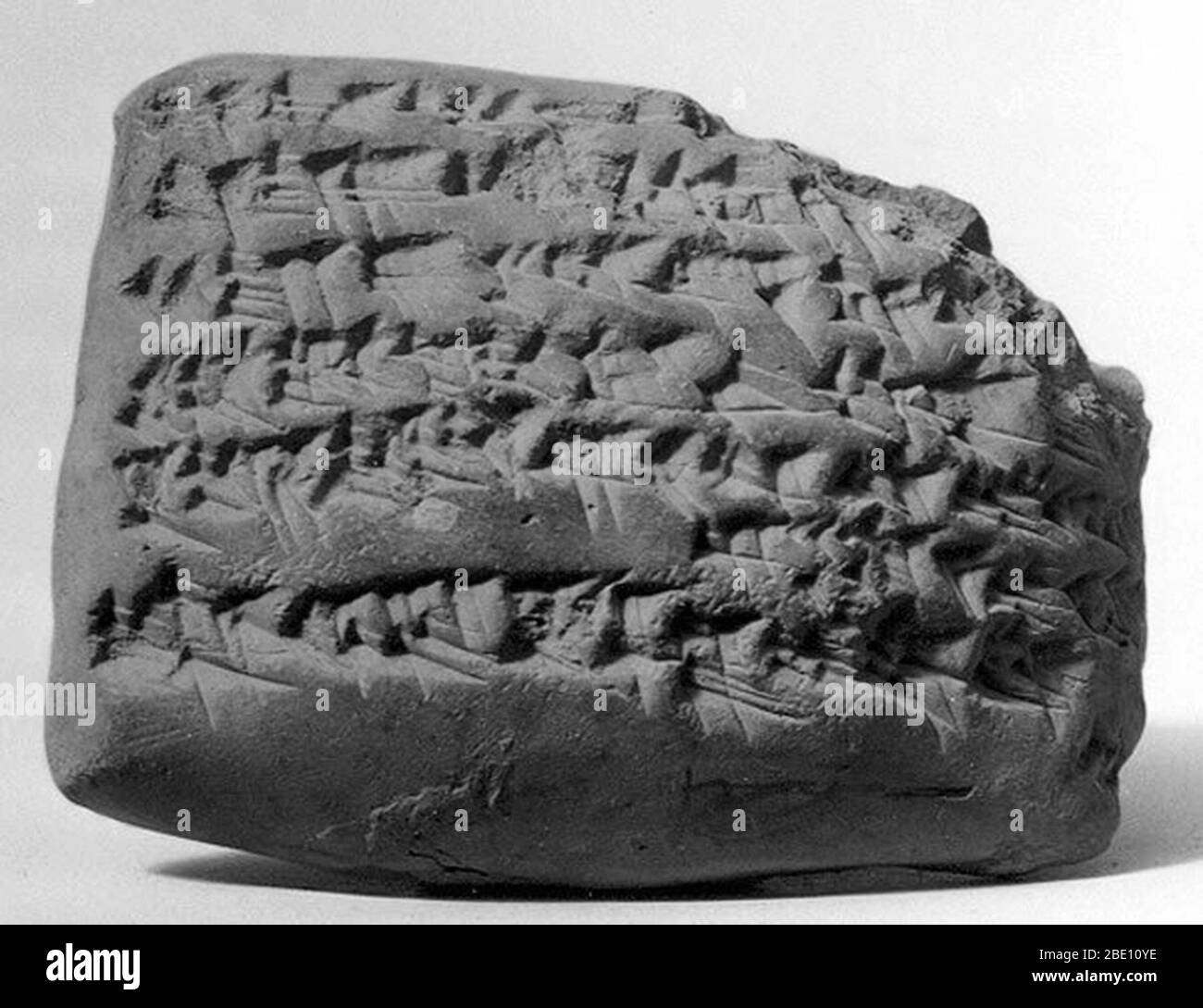 Cuneiform tablet. Gula incantation. Neo-Babylonian or Achaemenid, ca. mid- to late 1st millennium B.C. Probably from Sippar (modern Tell Abu Habba) in Mesopotamia. Proto-cuneiform is the name given to the earliest form of writing -- pictograms that were drawn on clay tablets. Gradually, the pictograms became abstracted into cuneiform (Latin, 'wedge-shaped') signs that were impressed rather than drawn. At its greatest extent, cuneiform writing was used from the Mediterranean coast of Syria to western Iran and from Hittite Anatolia to southern Mesopotamia. It was adapted to write at least fiftee Stock Photohttps://www.alamy.com/image-license-details/?v=1https://www.alamy.com/cuneiform-tablet-gula-incantation-neo-babylonian-or-achaemenid-ca-mid-to-late-1st-millennium-bc-probably-from-sippar-modern-tell-abu-habba-in-mesopotamia-proto-cuneiform-is-the-name-given-to-the-earliest-form-of-writing-pictograms-that-were-drawn-on-clay-tablets-gradually-the-pictograms-became-abstracted-into-cuneiform-latin-wedge-shaped-signs-that-were-impressed-rather-than-drawn-at-its-greatest-extent-cuneiform-writing-was-used-from-the-mediterranean-coast-of-syria-to-western-iran-and-from-hittite-anatolia-to-southern-mesopotamia-it-was-adapted-to-write-at-least-fiftee-image352835266.html
Cuneiform tablet. Gula incantation. Neo-Babylonian or Achaemenid, ca. mid- to late 1st millennium B.C. Probably from Sippar (modern Tell Abu Habba) in Mesopotamia. Proto-cuneiform is the name given to the earliest form of writing -- pictograms that were drawn on clay tablets. Gradually, the pictograms became abstracted into cuneiform (Latin, 'wedge-shaped') signs that were impressed rather than drawn. At its greatest extent, cuneiform writing was used from the Mediterranean coast of Syria to western Iran and from Hittite Anatolia to southern Mesopotamia. It was adapted to write at least fiftee Stock Photohttps://www.alamy.com/image-license-details/?v=1https://www.alamy.com/cuneiform-tablet-gula-incantation-neo-babylonian-or-achaemenid-ca-mid-to-late-1st-millennium-bc-probably-from-sippar-modern-tell-abu-habba-in-mesopotamia-proto-cuneiform-is-the-name-given-to-the-earliest-form-of-writing-pictograms-that-were-drawn-on-clay-tablets-gradually-the-pictograms-became-abstracted-into-cuneiform-latin-wedge-shaped-signs-that-were-impressed-rather-than-drawn-at-its-greatest-extent-cuneiform-writing-was-used-from-the-mediterranean-coast-of-syria-to-western-iran-and-from-hittite-anatolia-to-southern-mesopotamia-it-was-adapted-to-write-at-least-fiftee-image352835266.htmlRM2BE10YE–Cuneiform tablet. Gula incantation. Neo-Babylonian or Achaemenid, ca. mid- to late 1st millennium B.C. Probably from Sippar (modern Tell Abu Habba) in Mesopotamia. Proto-cuneiform is the name given to the earliest form of writing -- pictograms that were drawn on clay tablets. Gradually, the pictograms became abstracted into cuneiform (Latin, 'wedge-shaped') signs that were impressed rather than drawn. At its greatest extent, cuneiform writing was used from the Mediterranean coast of Syria to western Iran and from Hittite Anatolia to southern Mesopotamia. It was adapted to write at least fiftee
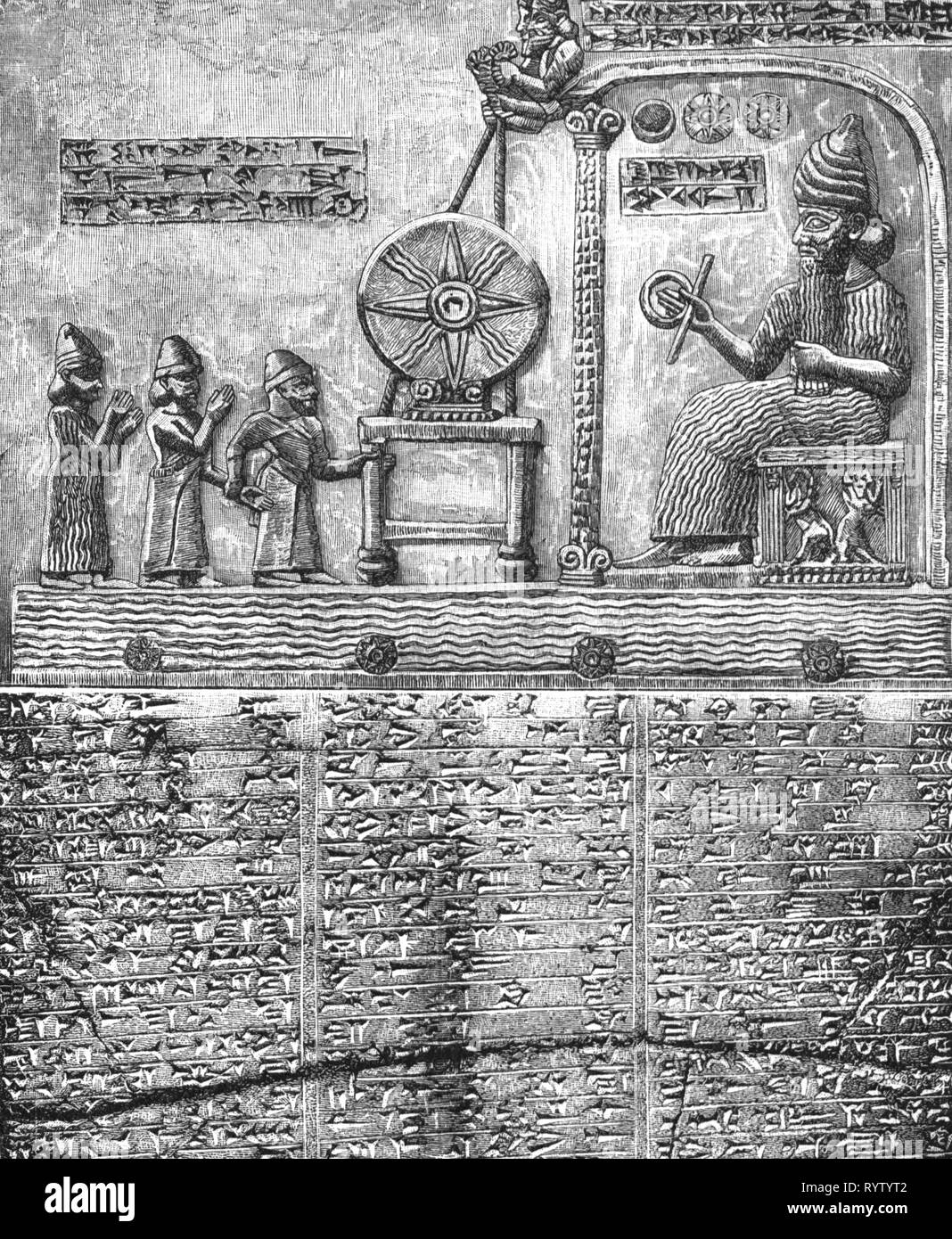 religion, sun worship, Babylonian sun god, after relief from sun temple of Sippar, 852 BC, today British Museum, London, wood engraving, 19th century, Additional-Rights-Clearance-Info-Not-Available Stock Photohttps://www.alamy.com/image-license-details/?v=1https://www.alamy.com/religion-sun-worship-babylonian-sun-god-after-relief-from-sun-temple-of-sippar-852-bc-today-british-museum-london-wood-engraving-19th-century-additional-rights-clearance-info-not-available-image240879186.html
religion, sun worship, Babylonian sun god, after relief from sun temple of Sippar, 852 BC, today British Museum, London, wood engraving, 19th century, Additional-Rights-Clearance-Info-Not-Available Stock Photohttps://www.alamy.com/image-license-details/?v=1https://www.alamy.com/religion-sun-worship-babylonian-sun-god-after-relief-from-sun-temple-of-sippar-852-bc-today-british-museum-london-wood-engraving-19th-century-additional-rights-clearance-info-not-available-image240879186.htmlRMRYTYT2–religion, sun worship, Babylonian sun god, after relief from sun temple of Sippar, 852 BC, today British Museum, London, wood engraving, 19th century, Additional-Rights-Clearance-Info-Not-Available
 19th-century illustration of cuneiform script. Published in Systematischer Bilder-Atlas zum Conversations-Lexikon, Ikonographische Encyklopaedie der W Stock Photohttps://www.alamy.com/image-license-details/?v=1https://www.alamy.com/19th-century-illustration-of-cuneiform-script-published-in-systematischer-bilder-atlas-zum-conversations-lexikon-ikonographische-encyklopaedie-der-w-image381533506.html
19th-century illustration of cuneiform script. Published in Systematischer Bilder-Atlas zum Conversations-Lexikon, Ikonographische Encyklopaedie der W Stock Photohttps://www.alamy.com/image-license-details/?v=1https://www.alamy.com/19th-century-illustration-of-cuneiform-script-published-in-systematischer-bilder-atlas-zum-conversations-lexikon-ikonographische-encyklopaedie-der-w-image381533506.htmlRF2D4M9TJ–19th-century illustration of cuneiform script. Published in Systematischer Bilder-Atlas zum Conversations-Lexikon, Ikonographische Encyklopaedie der W
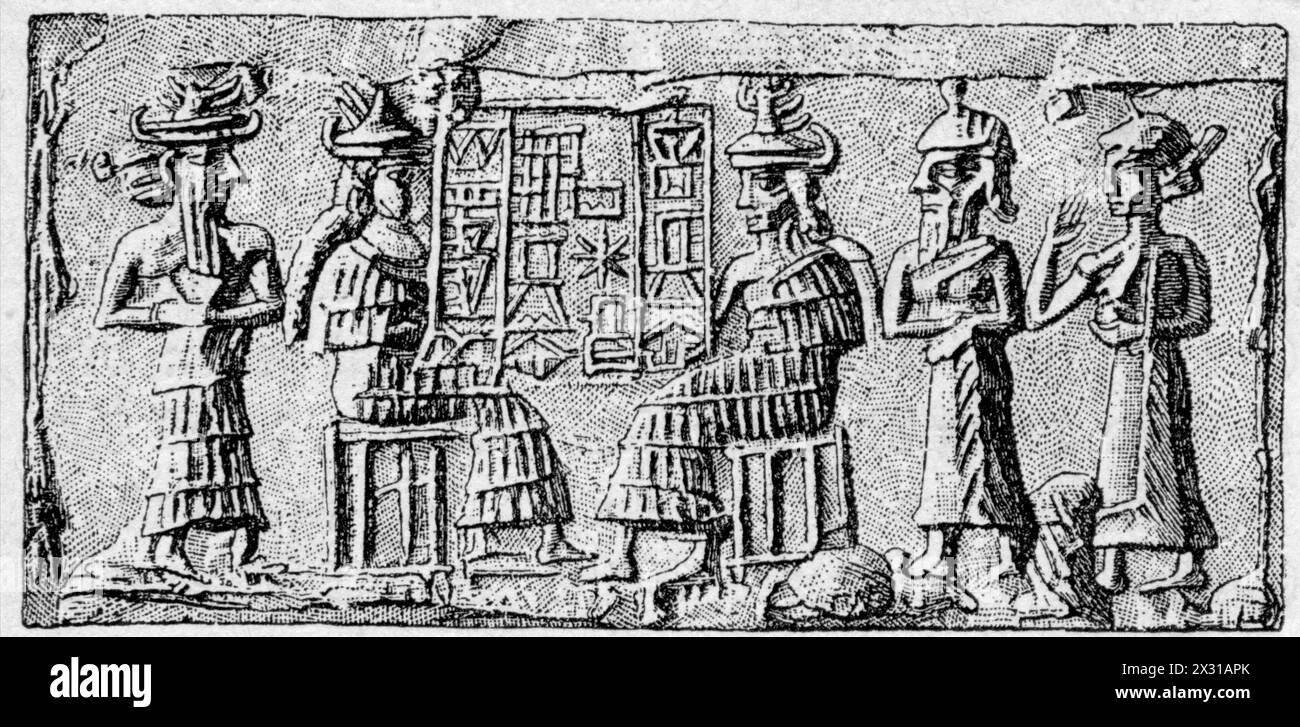 ancient world, Mesopotamia, Uruk, people, immigrating semites, wood engraving, 19th century, ADDITIONAL-RIGHTS-CLEARANCE-INFO-NOT-AVAILABLE Stock Photohttps://www.alamy.com/image-license-details/?v=1https://www.alamy.com/ancient-world-mesopotamia-uruk-people-immigrating-semites-wood-engraving-19th-century-additional-rights-clearance-info-not-available-image604237275.html
ancient world, Mesopotamia, Uruk, people, immigrating semites, wood engraving, 19th century, ADDITIONAL-RIGHTS-CLEARANCE-INFO-NOT-AVAILABLE Stock Photohttps://www.alamy.com/image-license-details/?v=1https://www.alamy.com/ancient-world-mesopotamia-uruk-people-immigrating-semites-wood-engraving-19th-century-additional-rights-clearance-info-not-available-image604237275.htmlRM2X31APK–ancient world, Mesopotamia, Uruk, people, immigrating semites, wood engraving, 19th century, ADDITIONAL-RIGHTS-CLEARANCE-INFO-NOT-AVAILABLE
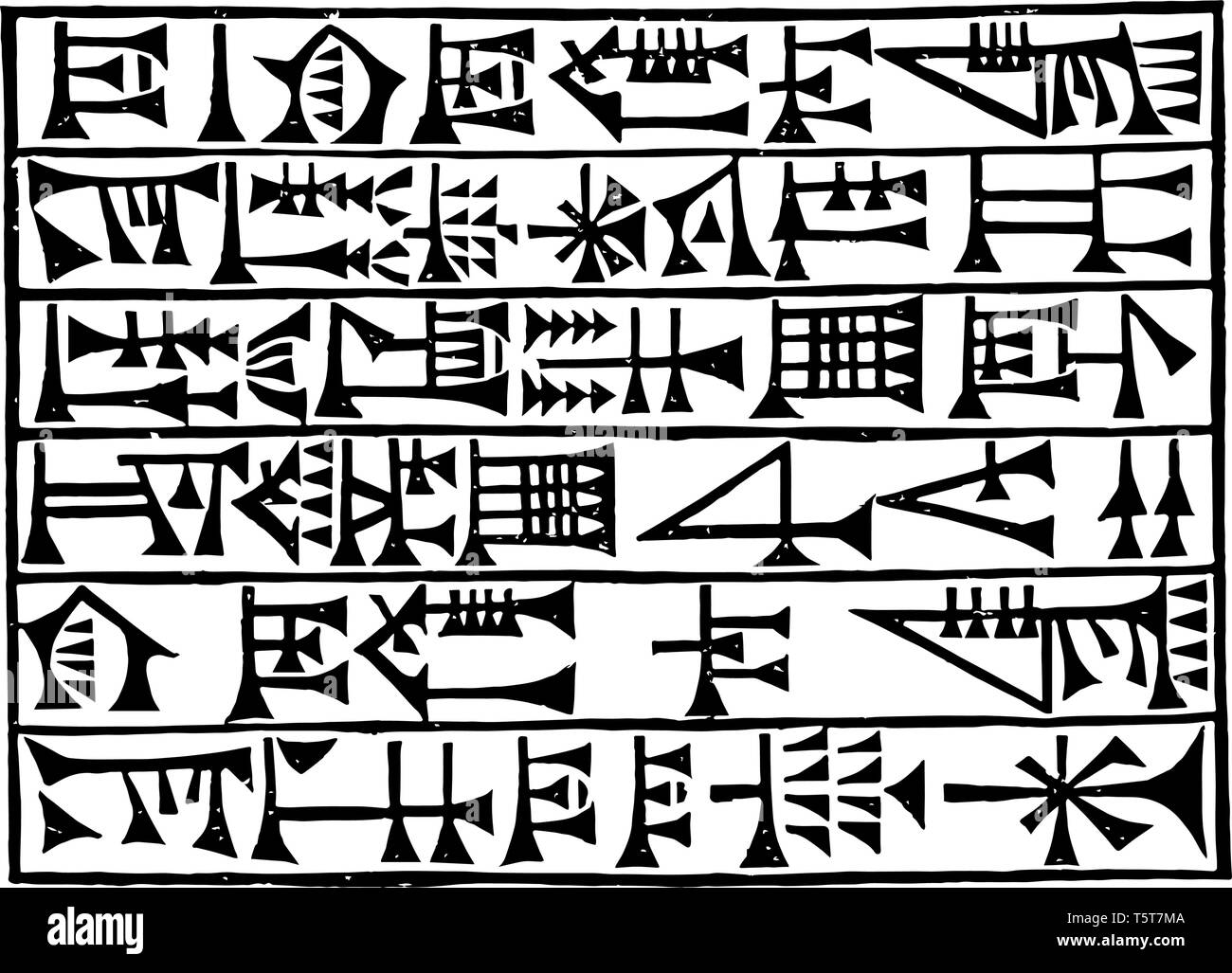 The image shows Babylonian script. It is one of the languages written in a row. Sumerian writing system called cuneiform, vintage line drawing or engr Stock Vectorhttps://www.alamy.com/image-license-details/?v=1https://www.alamy.com/the-image-shows-babylonian-script-it-is-one-of-the-languages-written-in-a-row-sumerian-writing-system-called-cuneiform-vintage-line-drawing-or-engr-image244551338.html
The image shows Babylonian script. It is one of the languages written in a row. Sumerian writing system called cuneiform, vintage line drawing or engr Stock Vectorhttps://www.alamy.com/image-license-details/?v=1https://www.alamy.com/the-image-shows-babylonian-script-it-is-one-of-the-languages-written-in-a-row-sumerian-writing-system-called-cuneiform-vintage-line-drawing-or-engr-image244551338.htmlRFT5T7MA–The image shows Babylonian script. It is one of the languages written in a row. Sumerian writing system called cuneiform, vintage line drawing or engr
 Inscription tablet on remedies, 3rd century BC Stock Photohttps://www.alamy.com/image-license-details/?v=1https://www.alamy.com/stock-photo-inscription-tablet-on-remedies-3rd-century-bc-95419867.html
Inscription tablet on remedies, 3rd century BC Stock Photohttps://www.alamy.com/image-license-details/?v=1https://www.alamy.com/stock-photo-inscription-tablet-on-remedies-3rd-century-bc-95419867.htmlRMFF6N0B–Inscription tablet on remedies, 3rd century BC
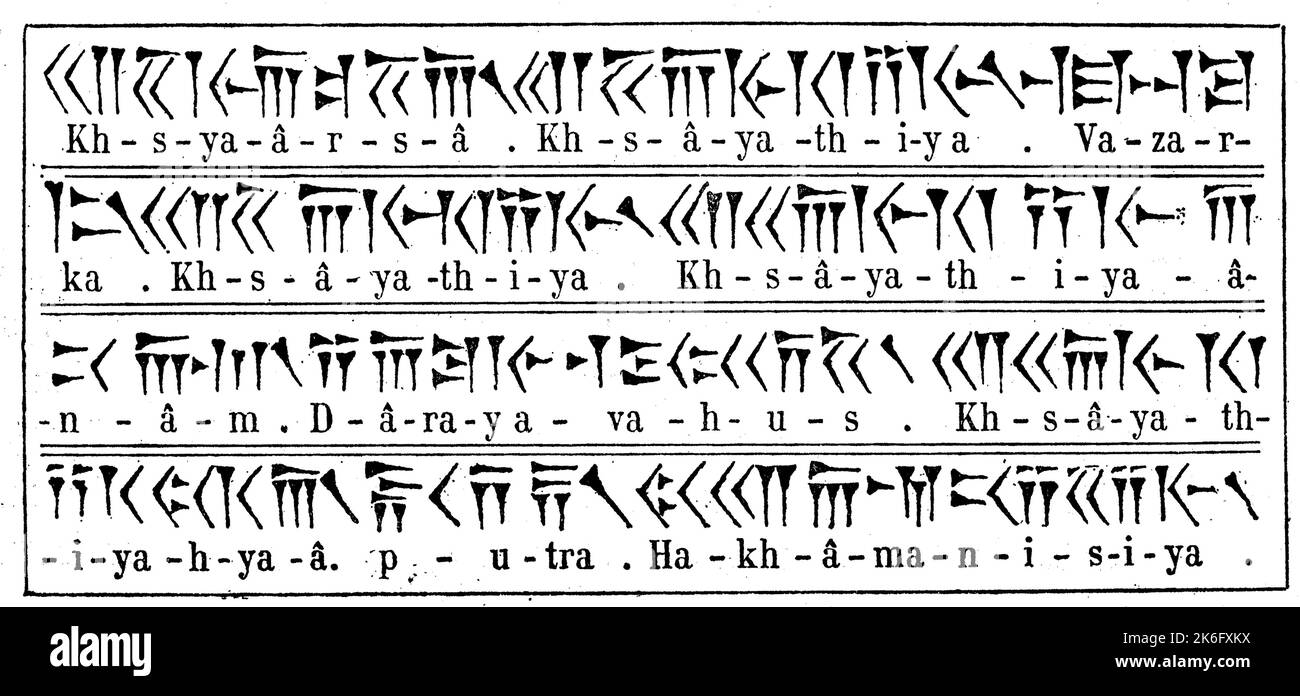 Kultur der Perser, Schrift des Xerxes, persische Keilschrift, von der babylonischen Keilschrift abgeleitet, Persien, Historisch, digital restaurierte Reproduktion einer Originalvorlage aus dem 19. Jahrhundert, genaues Originaldatum nicht bekannt / Persian culture, Xerxes script, Persian cuneiform, derived from Babylonian cuneiform, Persia, Historic, digitally restored reproduction of an original 19th century master, exact original date not known Stock Photohttps://www.alamy.com/image-license-details/?v=1https://www.alamy.com/kultur-der-perser-schrift-des-xerxes-persische-keilschrift-von-der-babylonischen-keilschrift-abgeleitet-persien-historisch-digital-restaurierte-reproduktion-einer-originalvorlage-aus-dem-19-jahrhundert-genaues-originaldatum-nicht-bekannt-persian-culture-xerxes-script-persian-cuneiform-derived-from-babylonian-cuneiform-persia-historic-digitally-restored-reproduction-of-an-original-19th-century-master-exact-original-date-not-known-image485928462.html
Kultur der Perser, Schrift des Xerxes, persische Keilschrift, von der babylonischen Keilschrift abgeleitet, Persien, Historisch, digital restaurierte Reproduktion einer Originalvorlage aus dem 19. Jahrhundert, genaues Originaldatum nicht bekannt / Persian culture, Xerxes script, Persian cuneiform, derived from Babylonian cuneiform, Persia, Historic, digitally restored reproduction of an original 19th century master, exact original date not known Stock Photohttps://www.alamy.com/image-license-details/?v=1https://www.alamy.com/kultur-der-perser-schrift-des-xerxes-persische-keilschrift-von-der-babylonischen-keilschrift-abgeleitet-persien-historisch-digital-restaurierte-reproduktion-einer-originalvorlage-aus-dem-19-jahrhundert-genaues-originaldatum-nicht-bekannt-persian-culture-xerxes-script-persian-cuneiform-derived-from-babylonian-cuneiform-persia-historic-digitally-restored-reproduction-of-an-original-19th-century-master-exact-original-date-not-known-image485928462.htmlRF2K6FXKX–Kultur der Perser, Schrift des Xerxes, persische Keilschrift, von der babylonischen Keilschrift abgeleitet, Persien, Historisch, digital restaurierte Reproduktion einer Originalvorlage aus dem 19. Jahrhundert, genaues Originaldatum nicht bekannt / Persian culture, Xerxes script, Persian cuneiform, derived from Babylonian cuneiform, Persia, Historic, digitally restored reproduction of an original 19th century master, exact original date not known
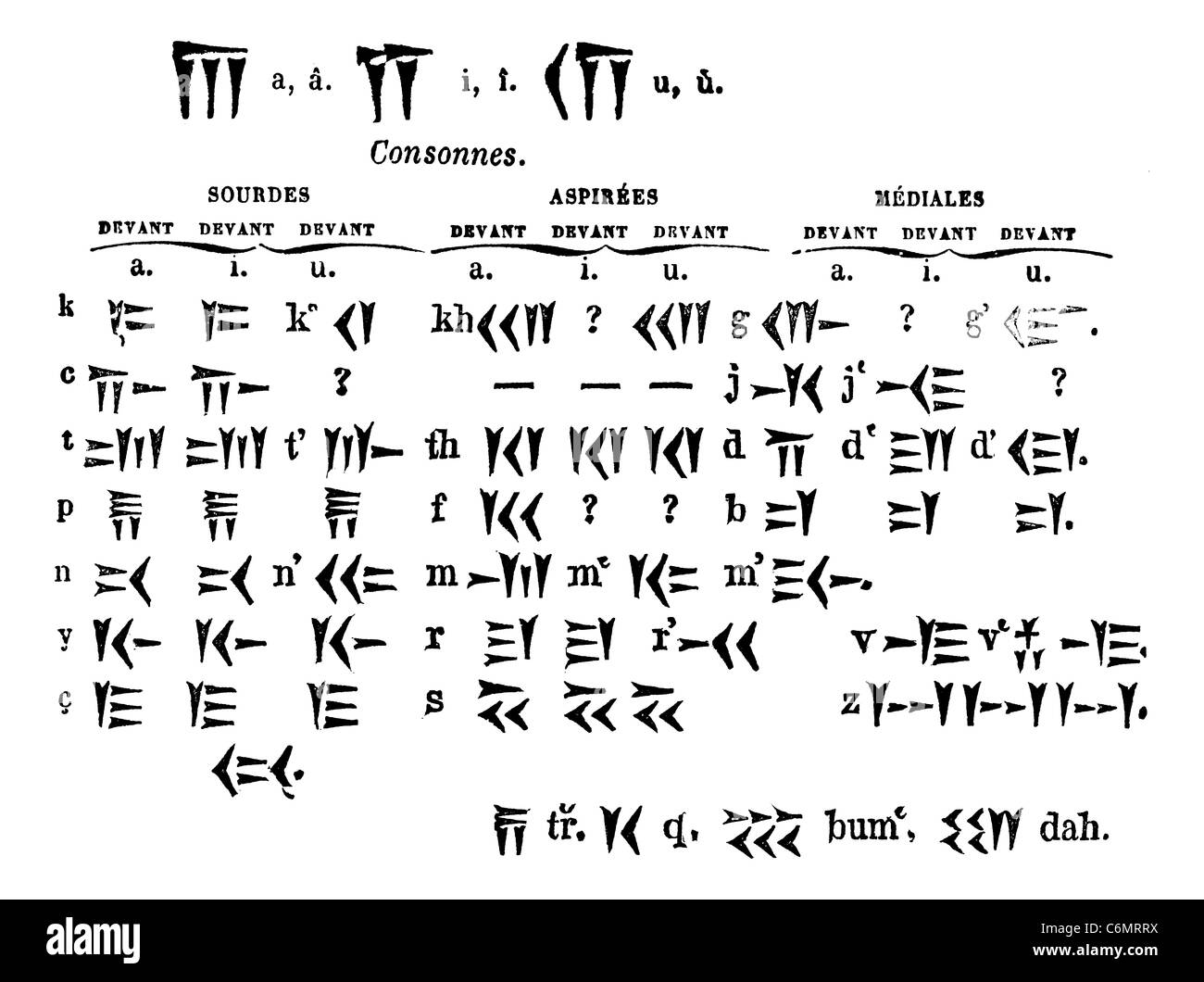 Cuneiform Script, vintage engraved illustration. Trousset encyclopedia (1886 - 1891). Stock Photohttps://www.alamy.com/image-license-details/?v=1https://www.alamy.com/stock-photo-cuneiform-script-vintage-engraved-illustration-trousset-encyclopedia-38566414.html
Cuneiform Script, vintage engraved illustration. Trousset encyclopedia (1886 - 1891). Stock Photohttps://www.alamy.com/image-license-details/?v=1https://www.alamy.com/stock-photo-cuneiform-script-vintage-engraved-illustration-trousset-encyclopedia-38566414.htmlRFC6MRRX–Cuneiform Script, vintage engraved illustration. Trousset encyclopedia (1886 - 1891).
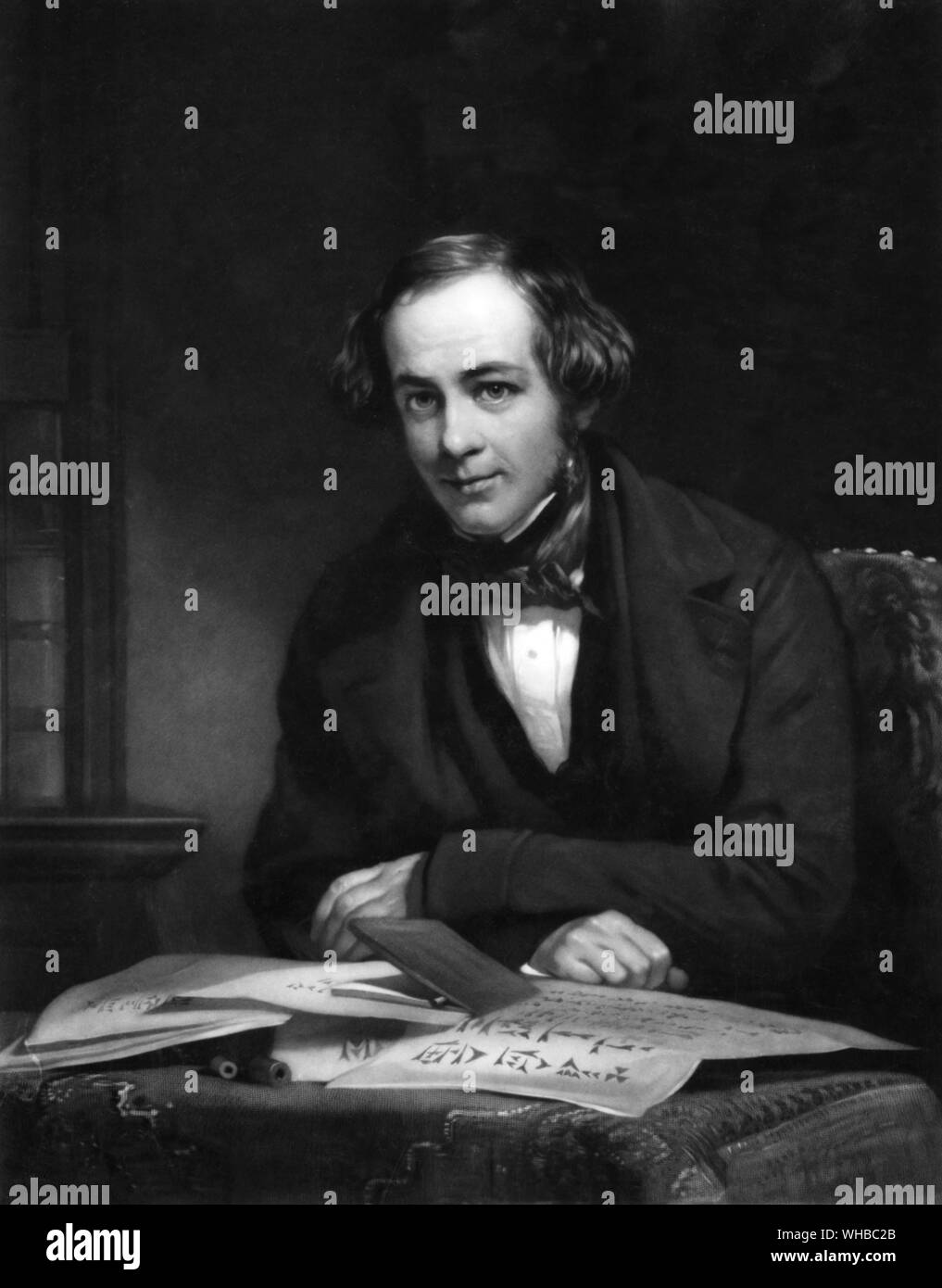 Major General Sir H. C. Rawling KCB -. Henry Creswicke Rawling - a British army officer and Orientalist who deciphered the Old Persian portion of the trilingual cuneiform inscription of Darius I the Great at Bisitun, Iran. Cuneiform is the same writing system, which was used on the clay, tablets and inscriptions used by the ancient inhabitants of Mesopotamia. His success provided the key to the deciphering, by himself and others, of Mesopotamian cuneiform script.. Stock Photohttps://www.alamy.com/image-license-details/?v=1https://www.alamy.com/major-general-sir-h-c-rawling-kcb-henry-creswicke-rawling-a-british-army-officer-and-orientalist-who-deciphered-the-old-persian-portion-of-the-trilingual-cuneiform-inscription-of-darius-i-the-great-at-bisitun-iran-cuneiform-is-the-same-writing-system-which-was-used-on-the-clay-tablets-and-inscriptions-used-by-the-ancient-inhabitants-of-mesopotamia-his-success-provided-the-key-to-the-deciphering-by-himself-and-others-of-mesopotamian-cuneiform-script-image268855619.html
Major General Sir H. C. Rawling KCB -. Henry Creswicke Rawling - a British army officer and Orientalist who deciphered the Old Persian portion of the trilingual cuneiform inscription of Darius I the Great at Bisitun, Iran. Cuneiform is the same writing system, which was used on the clay, tablets and inscriptions used by the ancient inhabitants of Mesopotamia. His success provided the key to the deciphering, by himself and others, of Mesopotamian cuneiform script.. Stock Photohttps://www.alamy.com/image-license-details/?v=1https://www.alamy.com/major-general-sir-h-c-rawling-kcb-henry-creswicke-rawling-a-british-army-officer-and-orientalist-who-deciphered-the-old-persian-portion-of-the-trilingual-cuneiform-inscription-of-darius-i-the-great-at-bisitun-iran-cuneiform-is-the-same-writing-system-which-was-used-on-the-clay-tablets-and-inscriptions-used-by-the-ancient-inhabitants-of-mesopotamia-his-success-provided-the-key-to-the-deciphering-by-himself-and-others-of-mesopotamian-cuneiform-script-image268855619.htmlRMWHBC2B–Major General Sir H. C. Rawling KCB -. Henry Creswicke Rawling - a British army officer and Orientalist who deciphered the Old Persian portion of the trilingual cuneiform inscription of Darius I the Great at Bisitun, Iran. Cuneiform is the same writing system, which was used on the clay, tablets and inscriptions used by the ancient inhabitants of Mesopotamia. His success provided the key to the deciphering, by himself and others, of Mesopotamian cuneiform script..
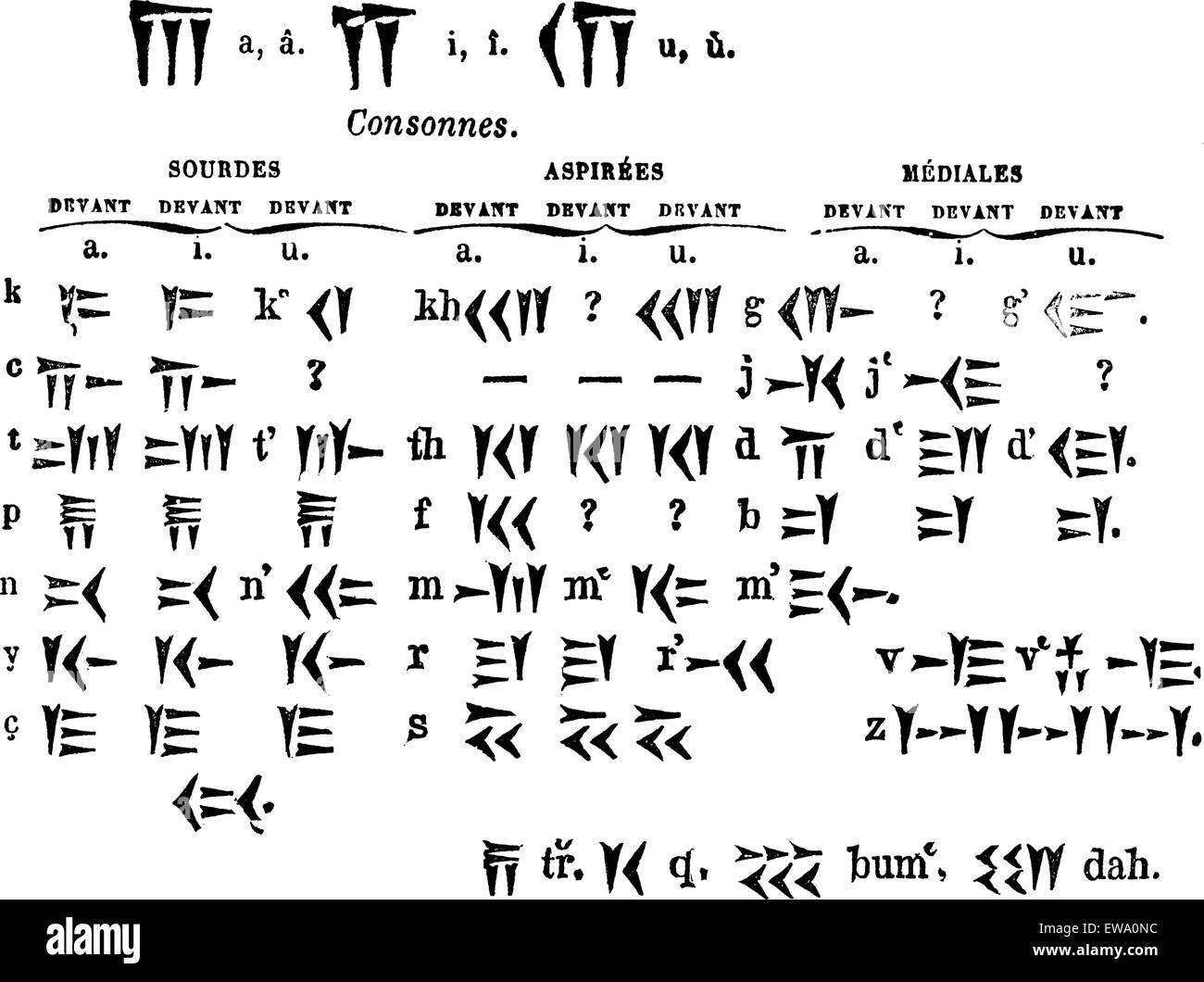 Cuneiform Script, vintage engraved illustration. Trousset encyclopedia (1886 - 1891). Stock Vectorhttps://www.alamy.com/image-license-details/?v=1https://www.alamy.com/stock-photo-cuneiform-script-vintage-engraved-illustration-trousset-encyclopedia-84427992.html
Cuneiform Script, vintage engraved illustration. Trousset encyclopedia (1886 - 1891). Stock Vectorhttps://www.alamy.com/image-license-details/?v=1https://www.alamy.com/stock-photo-cuneiform-script-vintage-engraved-illustration-trousset-encyclopedia-84427992.htmlRFEWA0NC–Cuneiform Script, vintage engraved illustration. Trousset encyclopedia (1886 - 1891).
RF2XG8XK0–Cuneiform Icon vector logo set collection for web app ui
 Beautiful sumerian and asyrian seamless pattern over marble background with cuneiform writtings Stock Vectorhttps://www.alamy.com/image-license-details/?v=1https://www.alamy.com/beautiful-sumerian-and-asyrian-seamless-pattern-over-marble-background-with-cuneiform-writtings-image608671423.html
Beautiful sumerian and asyrian seamless pattern over marble background with cuneiform writtings Stock Vectorhttps://www.alamy.com/image-license-details/?v=1https://www.alamy.com/beautiful-sumerian-and-asyrian-seamless-pattern-over-marble-background-with-cuneiform-writtings-image608671423.htmlRF2XA7AH3–Beautiful sumerian and asyrian seamless pattern over marble background with cuneiform writtings
RF2XGKXHC–Cuneiform Icon logo sign vector outline in black and white color
 ASSYRIAN INSCRIPTION Stock Photohttps://www.alamy.com/image-license-details/?v=1https://www.alamy.com/stock-photo-assyrian-inscription-105282971.html
ASSYRIAN INSCRIPTION Stock Photohttps://www.alamy.com/image-license-details/?v=1https://www.alamy.com/stock-photo-assyrian-inscription-105282971.htmlRMG381E3–ASSYRIAN INSCRIPTION
 History of Europe, ancient and medieval: Earliest man, the Orient, Greece and Rome . (p. 24, n. i). Trade and government led these people to make records,scratched in rude pictures with the tip of a reed on a flat pieceof soft clay. Speed in writing simplified these pictures intogroups of wedge-shaped marks, once the lines of the picture(Fig. 21). Hence these signs are called cuneiform, meaningwedge-form, writing (Latin cuneus, wedge). This writingwas phonetic, but did not possess alphabetic signs. The Sumerian system of numerals was not based on tens, buthad the unit sixty as a basis. A large Stock Photohttps://www.alamy.com/image-license-details/?v=1https://www.alamy.com/history-of-europe-ancient-and-medieval-earliest-man-the-orient-greece-and-rome-p-24-n-i-trade-and-government-led-these-people-to-make-recordsscratched-in-rude-pictures-with-the-tip-of-a-reed-on-a-flat-pieceof-soft-clay-speed-in-writing-simplified-these-pictures-intogroups-of-wedge-shaped-marks-once-the-lines-of-the-picturefig-21-hence-these-signs-are-called-cuneiform-meaningwedge-form-writing-latin-cuneus-wedge-this-writingwas-phonetic-but-did-not-possess-alphabetic-signs-the-sumerian-system-of-numerals-was-not-based-on-tens-buthad-the-unit-sixty-as-a-basis-a-large-image339158507.html
History of Europe, ancient and medieval: Earliest man, the Orient, Greece and Rome . (p. 24, n. i). Trade and government led these people to make records,scratched in rude pictures with the tip of a reed on a flat pieceof soft clay. Speed in writing simplified these pictures intogroups of wedge-shaped marks, once the lines of the picture(Fig. 21). Hence these signs are called cuneiform, meaningwedge-form, writing (Latin cuneus, wedge). This writingwas phonetic, but did not possess alphabetic signs. The Sumerian system of numerals was not based on tens, buthad the unit sixty as a basis. A large Stock Photohttps://www.alamy.com/image-license-details/?v=1https://www.alamy.com/history-of-europe-ancient-and-medieval-earliest-man-the-orient-greece-and-rome-p-24-n-i-trade-and-government-led-these-people-to-make-recordsscratched-in-rude-pictures-with-the-tip-of-a-reed-on-a-flat-pieceof-soft-clay-speed-in-writing-simplified-these-pictures-intogroups-of-wedge-shaped-marks-once-the-lines-of-the-picturefig-21-hence-these-signs-are-called-cuneiform-meaningwedge-form-writing-latin-cuneus-wedge-this-writingwas-phonetic-but-did-not-possess-alphabetic-signs-the-sumerian-system-of-numerals-was-not-based-on-tens-buthad-the-unit-sixty-as-a-basis-a-large-image339158507.htmlRM2AKP03R–History of Europe, ancient and medieval: Earliest man, the Orient, Greece and Rome . (p. 24, n. i). Trade and government led these people to make records,scratched in rude pictures with the tip of a reed on a flat pieceof soft clay. Speed in writing simplified these pictures intogroups of wedge-shaped marks, once the lines of the picture(Fig. 21). Hence these signs are called cuneiform, meaningwedge-form, writing (Latin cuneus, wedge). This writingwas phonetic, but did not possess alphabetic signs. The Sumerian system of numerals was not based on tens, buthad the unit sixty as a basis. A large
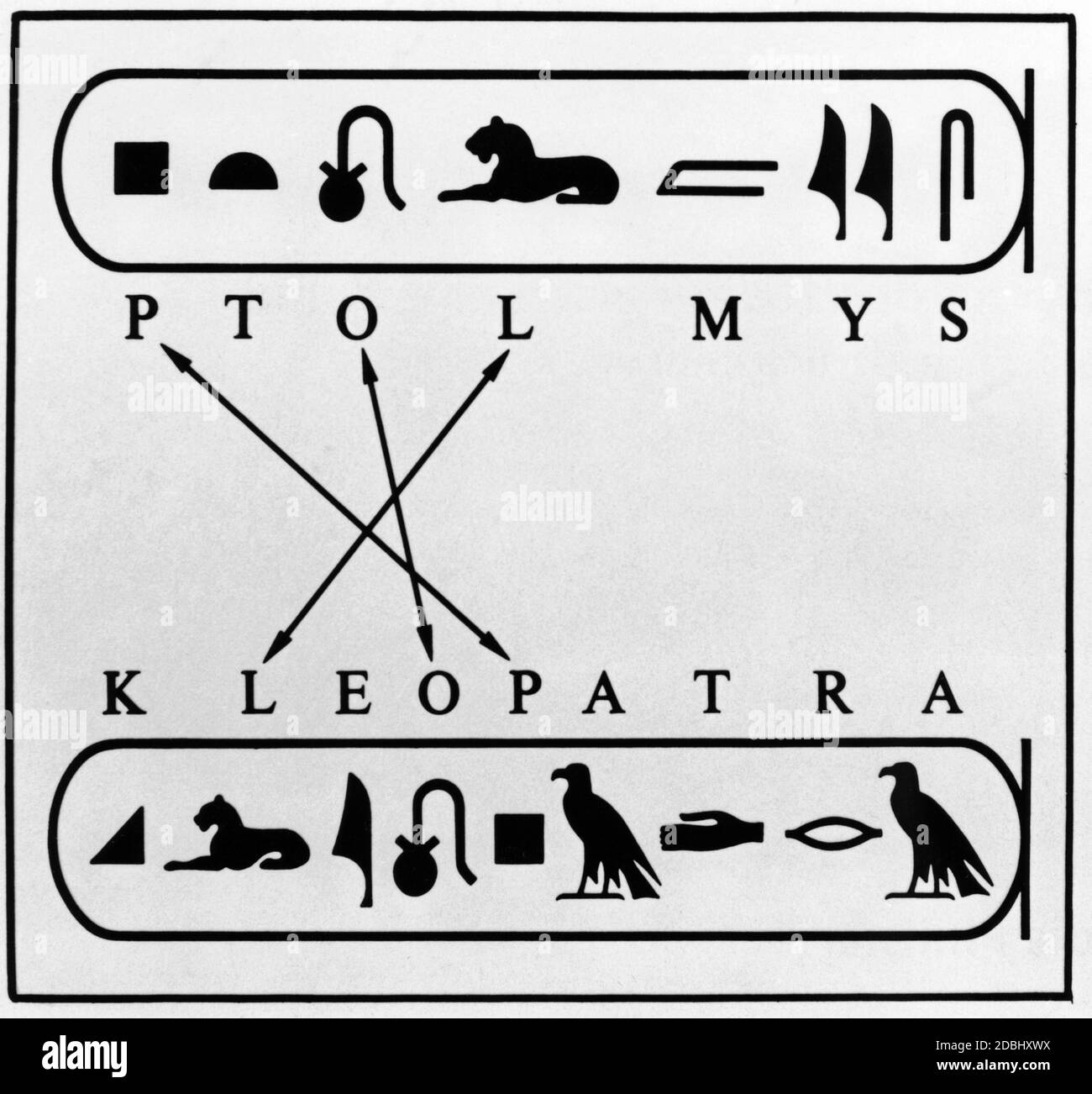 The picture shows the principle by which the French Egyptologist deciphered the Rosetta Stone. In 1799, a stone tablet was found near the Egyptian village of Rosetta. The inscription was carved in three languages: demotic, Greek and late Egyptian. Champollion was able to decipher the name of King Ptolys (Ptolomew) and Queen Cleopatra on an obelisk from Philae and thus the inscription. Stock Photohttps://www.alamy.com/image-license-details/?v=1https://www.alamy.com/the-picture-shows-the-principle-by-which-the-french-egyptologist-deciphered-the-rosetta-stone-in-1799-a-stone-tablet-was-found-near-the-egyptian-village-of-rosetta-the-inscription-was-carved-in-three-languages-demotic-greek-and-late-egyptian-champollion-was-able-to-decipher-the-name-of-king-ptolys-ptolomew-and-queen-cleopatra-on-an-obelisk-from-philae-and-thus-the-inscription-image385783606.html
The picture shows the principle by which the French Egyptologist deciphered the Rosetta Stone. In 1799, a stone tablet was found near the Egyptian village of Rosetta. The inscription was carved in three languages: demotic, Greek and late Egyptian. Champollion was able to decipher the name of King Ptolys (Ptolomew) and Queen Cleopatra on an obelisk from Philae and thus the inscription. Stock Photohttps://www.alamy.com/image-license-details/?v=1https://www.alamy.com/the-picture-shows-the-principle-by-which-the-french-egyptologist-deciphered-the-rosetta-stone-in-1799-a-stone-tablet-was-found-near-the-egyptian-village-of-rosetta-the-inscription-was-carved-in-three-languages-demotic-greek-and-late-egyptian-champollion-was-able-to-decipher-the-name-of-king-ptolys-ptolomew-and-queen-cleopatra-on-an-obelisk-from-philae-and-thus-the-inscription-image385783606.htmlRM2DBHXWX–The picture shows the principle by which the French Egyptologist deciphered the Rosetta Stone. In 1799, a stone tablet was found near the Egyptian village of Rosetta. The inscription was carved in three languages: demotic, Greek and late Egyptian. Champollion was able to decipher the name of King Ptolys (Ptolomew) and Queen Cleopatra on an obelisk from Philae and thus the inscription.
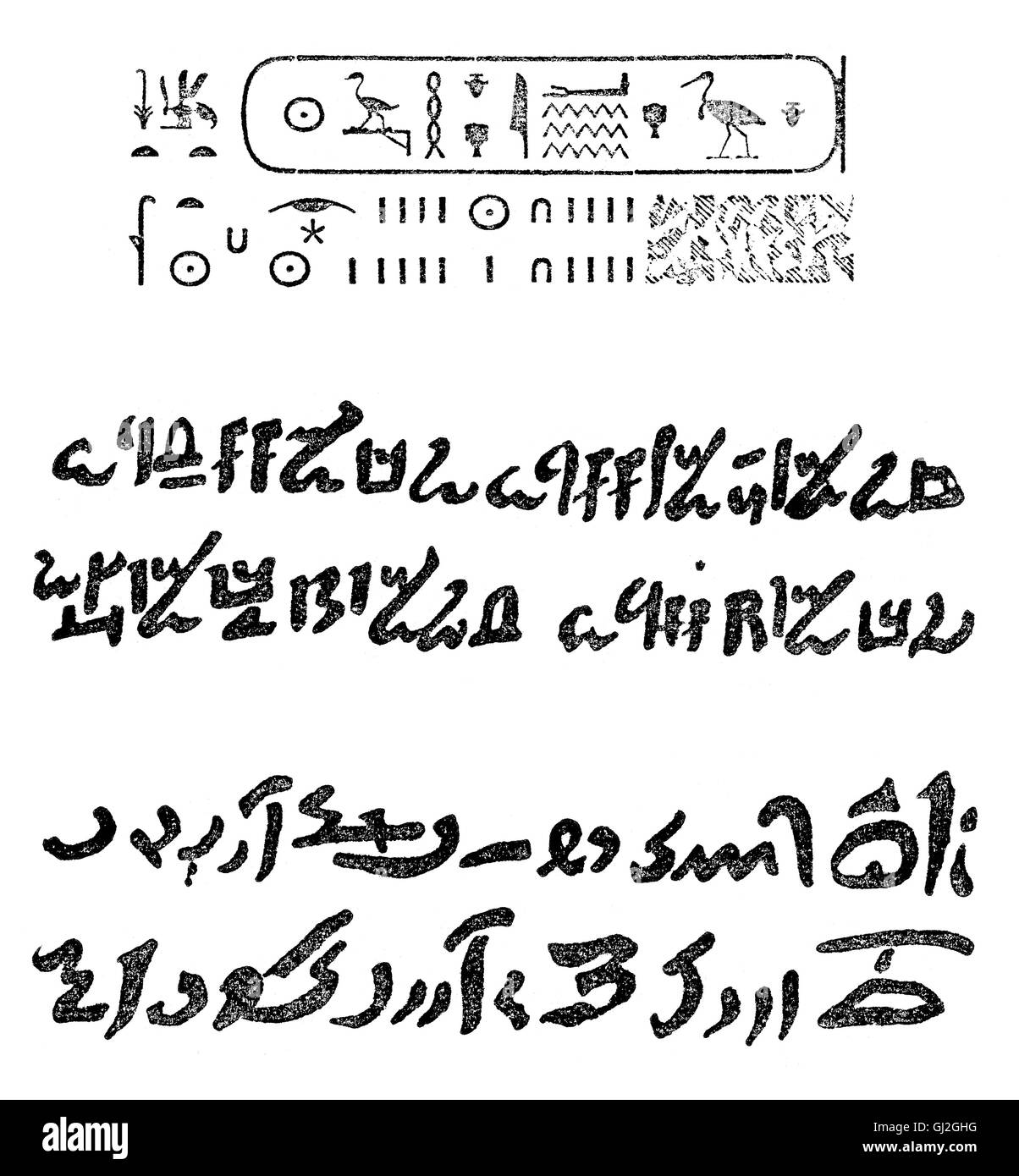 Hieroglyphs, hieratic and Demotic, ancient Egyptian scripts Stock Photohttps://www.alamy.com/image-license-details/?v=1https://www.alamy.com/stock-photo-hieroglyphs-hieratic-and-demotic-ancient-egyptian-scripts-114382956.html
Hieroglyphs, hieratic and Demotic, ancient Egyptian scripts Stock Photohttps://www.alamy.com/image-license-details/?v=1https://www.alamy.com/stock-photo-hieroglyphs-hieratic-and-demotic-ancient-egyptian-scripts-114382956.htmlRMGJ2GHG–Hieroglyphs, hieratic and Demotic, ancient Egyptian scripts
 Ancient Babylonian Stone Tablet illustration Stock Photohttps://www.alamy.com/image-license-details/?v=1https://www.alamy.com/ancient-babylonian-stone-tablet-illustration-image412801535.html
Ancient Babylonian Stone Tablet illustration Stock Photohttps://www.alamy.com/image-license-details/?v=1https://www.alamy.com/ancient-babylonian-stone-tablet-illustration-image412801535.htmlRF2EYGMFY–Ancient Babylonian Stone Tablet illustration
 A Novel Departure in the Field of Electric Heating. Automatic Street Lighting in London. A Wicker Lifeboat. THE ORIGIN OF THE STAR AND CRESCENT. BY EDGAR J. BANKS. on the Border of an Ancient Persian Coin. Evolution of the Star and Crescent from the Original Hieroglyph to the Cuneiform Writing. THE ORIGIN OF THE STAR AND CRESCENT. The Charred Ceiling., scientific american, 1908-05-09 Stock Photohttps://www.alamy.com/image-license-details/?v=1https://www.alamy.com/a-novel-departure-in-the-field-of-electric-heating-automatic-street-lighting-in-london-a-wicker-lifeboat-the-origin-of-the-star-and-crescent-by-edgar-j-banks-on-the-border-of-an-ancient-persian-coin-evolution-of-the-star-and-crescent-from-the-original-hieroglyph-to-the-cuneiform-writing-the-origin-of-the-star-and-crescent-the-charred-ceiling-scientific-american-1908-05-09-image334353516.html
A Novel Departure in the Field of Electric Heating. Automatic Street Lighting in London. A Wicker Lifeboat. THE ORIGIN OF THE STAR AND CRESCENT. BY EDGAR J. BANKS. on the Border of an Ancient Persian Coin. Evolution of the Star and Crescent from the Original Hieroglyph to the Cuneiform Writing. THE ORIGIN OF THE STAR AND CRESCENT. The Charred Ceiling., scientific american, 1908-05-09 Stock Photohttps://www.alamy.com/image-license-details/?v=1https://www.alamy.com/a-novel-departure-in-the-field-of-electric-heating-automatic-street-lighting-in-london-a-wicker-lifeboat-the-origin-of-the-star-and-crescent-by-edgar-j-banks-on-the-border-of-an-ancient-persian-coin-evolution-of-the-star-and-crescent-from-the-original-hieroglyph-to-the-cuneiform-writing-the-origin-of-the-star-and-crescent-the-charred-ceiling-scientific-american-1908-05-09-image334353516.htmlRM2ABY390–A Novel Departure in the Field of Electric Heating. Automatic Street Lighting in London. A Wicker Lifeboat. THE ORIGIN OF THE STAR AND CRESCENT. BY EDGAR J. BANKS. on the Border of an Ancient Persian Coin. Evolution of the Star and Crescent from the Original Hieroglyph to the Cuneiform Writing. THE ORIGIN OF THE STAR AND CRESCENT. The Charred Ceiling., scientific american, 1908-05-09
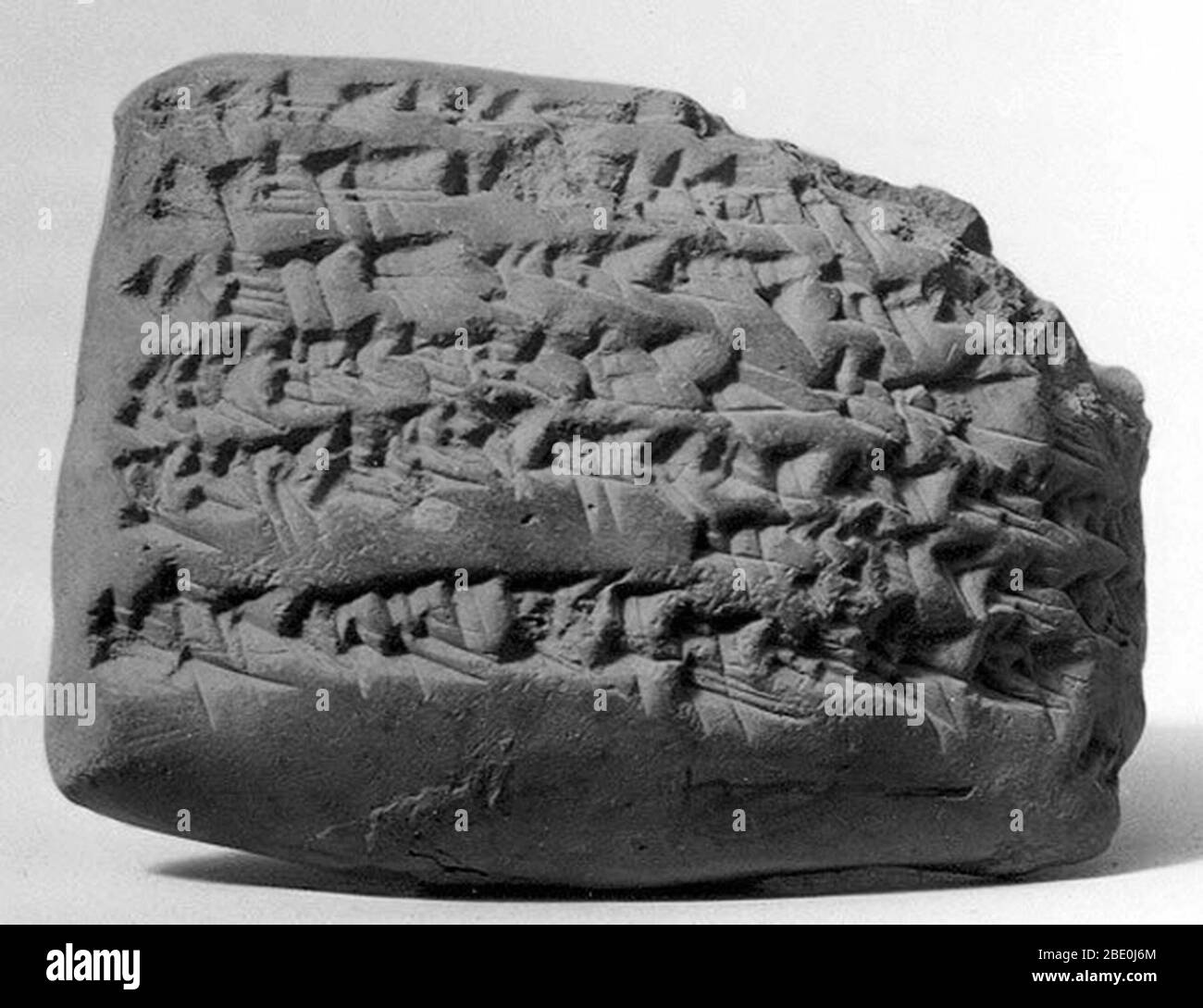 Cuneiform tablet. Gula incantation. Neo-Babylonian or Achaemenid, ca. mid- to late 1st millennium B.C. Probably from Sippar (modern Tell Abu Habba) in Mesopotamia. Proto-cuneiform is the name given to the earliest form of writing -- pictograms that were drawn on clay tablets. Gradually, the pictograms became abstracted into cuneiform (Latin, 'wedge-shaped') signs that were impressed rather than drawn. At its greatest extent, cuneiform writing was used from the Mediterranean coast of Syria to western Iran and from Hittite Anatolia to southern Mesopotamia. It was adapted to write at least fiftee Stock Photohttps://www.alamy.com/image-license-details/?v=1https://www.alamy.com/cuneiform-tablet-gula-incantation-neo-babylonian-or-achaemenid-ca-mid-to-late-1st-millennium-bc-probably-from-sippar-modern-tell-abu-habba-in-mesopotamia-proto-cuneiform-is-the-name-given-to-the-earliest-form-of-writing-pictograms-that-were-drawn-on-clay-tablets-gradually-the-pictograms-became-abstracted-into-cuneiform-latin-wedge-shaped-signs-that-were-impressed-rather-than-drawn-at-its-greatest-extent-cuneiform-writing-was-used-from-the-mediterranean-coast-of-syria-to-western-iran-and-from-hittite-anatolia-to-southern-mesopotamia-it-was-adapted-to-write-at-least-fiftee-image352826844.html
Cuneiform tablet. Gula incantation. Neo-Babylonian or Achaemenid, ca. mid- to late 1st millennium B.C. Probably from Sippar (modern Tell Abu Habba) in Mesopotamia. Proto-cuneiform is the name given to the earliest form of writing -- pictograms that were drawn on clay tablets. Gradually, the pictograms became abstracted into cuneiform (Latin, 'wedge-shaped') signs that were impressed rather than drawn. At its greatest extent, cuneiform writing was used from the Mediterranean coast of Syria to western Iran and from Hittite Anatolia to southern Mesopotamia. It was adapted to write at least fiftee Stock Photohttps://www.alamy.com/image-license-details/?v=1https://www.alamy.com/cuneiform-tablet-gula-incantation-neo-babylonian-or-achaemenid-ca-mid-to-late-1st-millennium-bc-probably-from-sippar-modern-tell-abu-habba-in-mesopotamia-proto-cuneiform-is-the-name-given-to-the-earliest-form-of-writing-pictograms-that-were-drawn-on-clay-tablets-gradually-the-pictograms-became-abstracted-into-cuneiform-latin-wedge-shaped-signs-that-were-impressed-rather-than-drawn-at-its-greatest-extent-cuneiform-writing-was-used-from-the-mediterranean-coast-of-syria-to-western-iran-and-from-hittite-anatolia-to-southern-mesopotamia-it-was-adapted-to-write-at-least-fiftee-image352826844.htmlRM2BE0J6M–Cuneiform tablet. Gula incantation. Neo-Babylonian or Achaemenid, ca. mid- to late 1st millennium B.C. Probably from Sippar (modern Tell Abu Habba) in Mesopotamia. Proto-cuneiform is the name given to the earliest form of writing -- pictograms that were drawn on clay tablets. Gradually, the pictograms became abstracted into cuneiform (Latin, 'wedge-shaped') signs that were impressed rather than drawn. At its greatest extent, cuneiform writing was used from the Mediterranean coast of Syria to western Iran and from Hittite Anatolia to southern Mesopotamia. It was adapted to write at least fiftee
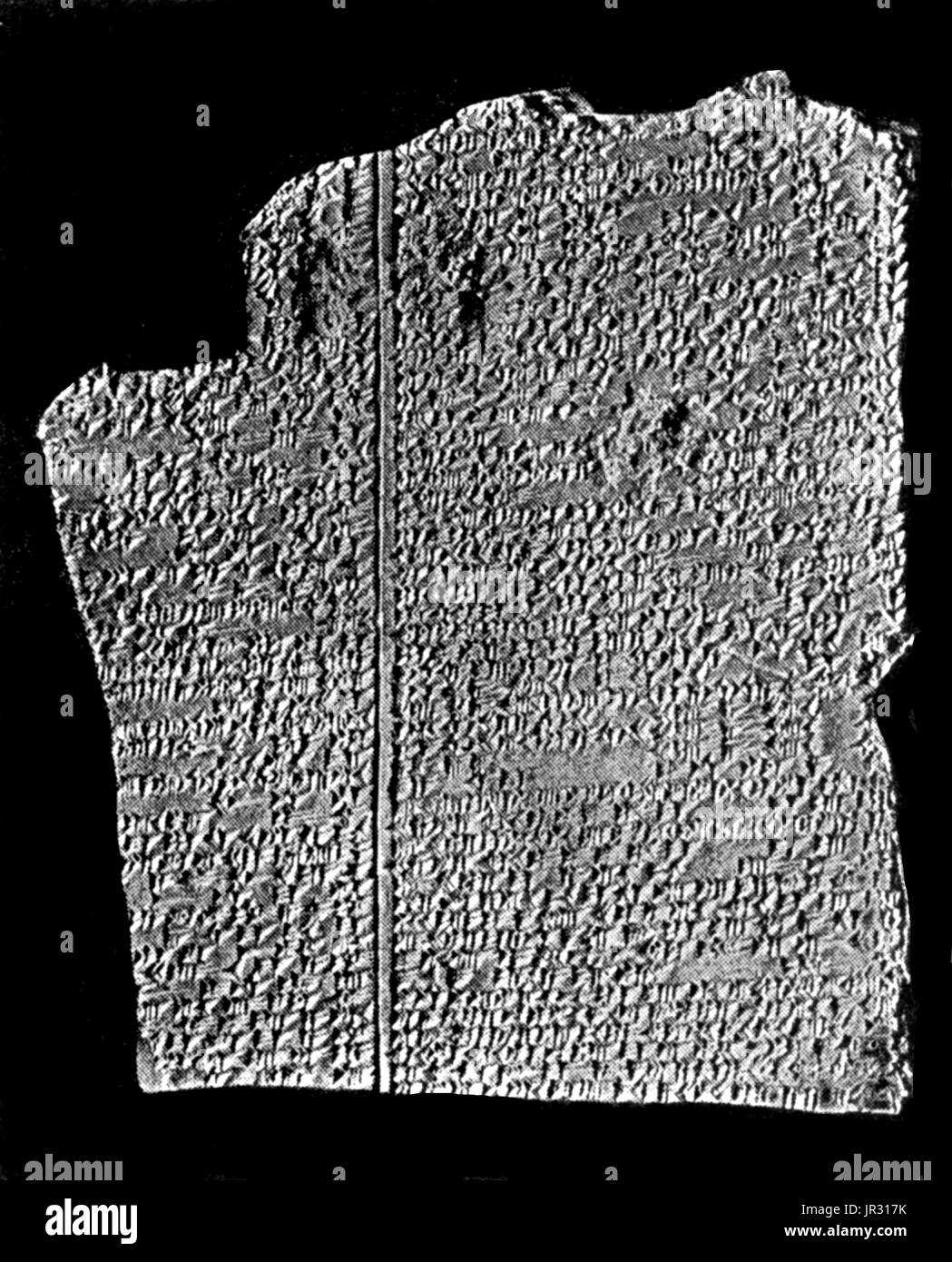 The Amarna tablets are an archive, written on clay tablets, primarily consisting of diplomatic correspondence between the Egyptian administration and its representatives in Canaan and Amurru during the New Kingdom. The Amarna letters are unusual in Egyptological research, because they are mostly written in Akkadian cuneiform, the writing system of ancient Mesopotamia, rather than that of ancient Egypt. The written correspondence spans a period of at most thirty years. The Amarna letters are of great significance for biblical studies as well as Semitic linguistics, since they shed light on the Stock Photohttps://www.alamy.com/image-license-details/?v=1https://www.alamy.com/the-amarna-tablets-are-an-archive-written-on-clay-tablets-primarily-image151886887.html
The Amarna tablets are an archive, written on clay tablets, primarily consisting of diplomatic correspondence between the Egyptian administration and its representatives in Canaan and Amurru during the New Kingdom. The Amarna letters are unusual in Egyptological research, because they are mostly written in Akkadian cuneiform, the writing system of ancient Mesopotamia, rather than that of ancient Egypt. The written correspondence spans a period of at most thirty years. The Amarna letters are of great significance for biblical studies as well as Semitic linguistics, since they shed light on the Stock Photohttps://www.alamy.com/image-license-details/?v=1https://www.alamy.com/the-amarna-tablets-are-an-archive-written-on-clay-tablets-primarily-image151886887.htmlRMJR317K–The Amarna tablets are an archive, written on clay tablets, primarily consisting of diplomatic correspondence between the Egyptian administration and its representatives in Canaan and Amurru during the New Kingdom. The Amarna letters are unusual in Egyptological research, because they are mostly written in Akkadian cuneiform, the writing system of ancient Mesopotamia, rather than that of ancient Egypt. The written correspondence spans a period of at most thirty years. The Amarna letters are of great significance for biblical studies as well as Semitic linguistics, since they shed light on the
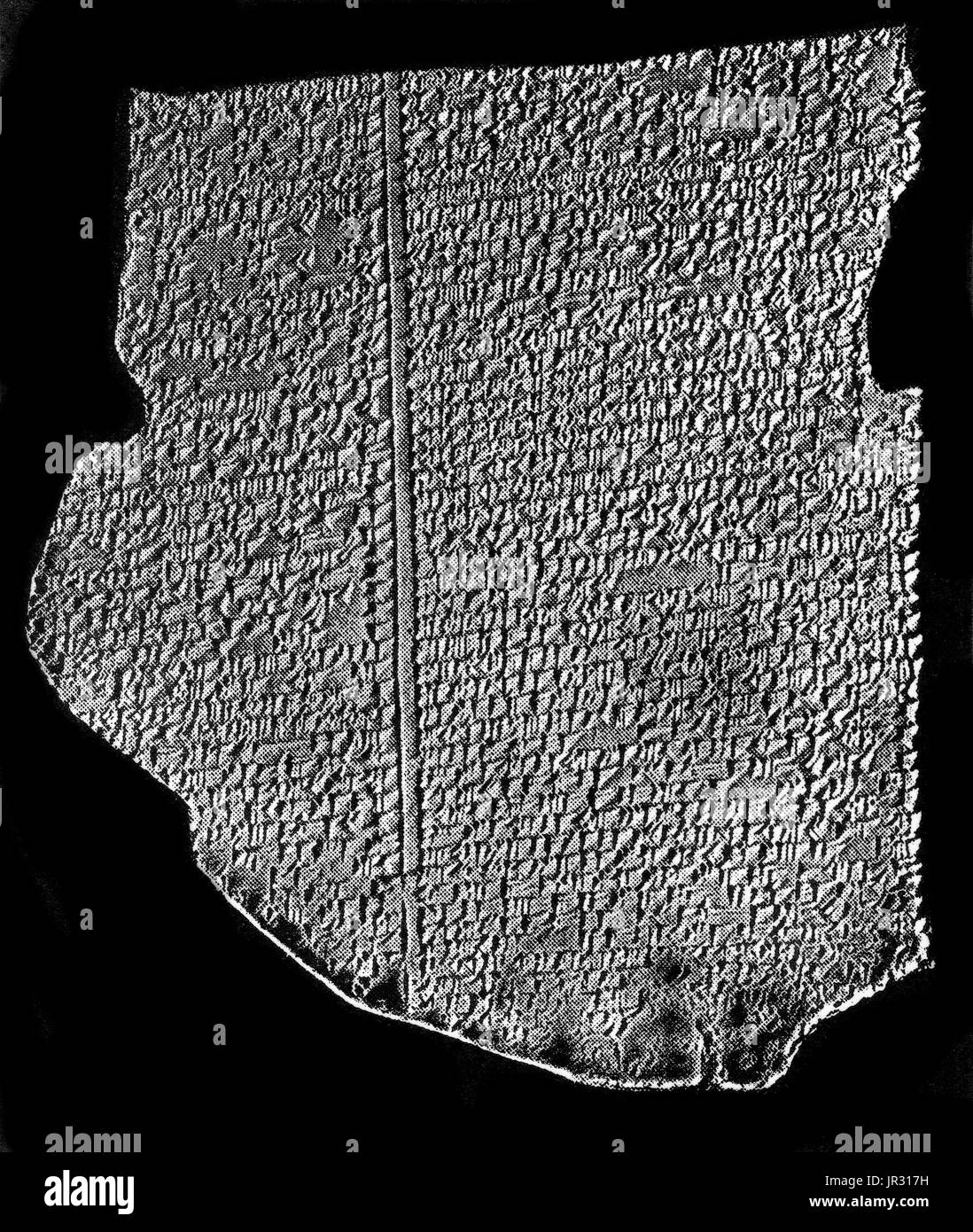 The Amarna tablets are an archive, written on clay tablets, primarily consisting of diplomatic correspondence between the Egyptian administration and its representatives in Canaan and Amurru during the New Kingdom. The Amarna letters are unusual in Egyptological research, because they are mostly written in Akkadian cuneiform, the writing system of ancient Mesopotamia, rather than that of ancient Egypt. The written correspondence spans a period of at most thirty years. The Amarna letters are of great significance for biblical studies as well as Semitic linguistics, since they shed light on the Stock Photohttps://www.alamy.com/image-license-details/?v=1https://www.alamy.com/the-amarna-tablets-are-an-archive-written-on-clay-tablets-primarily-image151886885.html
The Amarna tablets are an archive, written on clay tablets, primarily consisting of diplomatic correspondence between the Egyptian administration and its representatives in Canaan and Amurru during the New Kingdom. The Amarna letters are unusual in Egyptological research, because they are mostly written in Akkadian cuneiform, the writing system of ancient Mesopotamia, rather than that of ancient Egypt. The written correspondence spans a period of at most thirty years. The Amarna letters are of great significance for biblical studies as well as Semitic linguistics, since they shed light on the Stock Photohttps://www.alamy.com/image-license-details/?v=1https://www.alamy.com/the-amarna-tablets-are-an-archive-written-on-clay-tablets-primarily-image151886885.htmlRMJR317H–The Amarna tablets are an archive, written on clay tablets, primarily consisting of diplomatic correspondence between the Egyptian administration and its representatives in Canaan and Amurru during the New Kingdom. The Amarna letters are unusual in Egyptological research, because they are mostly written in Akkadian cuneiform, the writing system of ancient Mesopotamia, rather than that of ancient Egypt. The written correspondence spans a period of at most thirty years. The Amarna letters are of great significance for biblical studies as well as Semitic linguistics, since they shed light on the
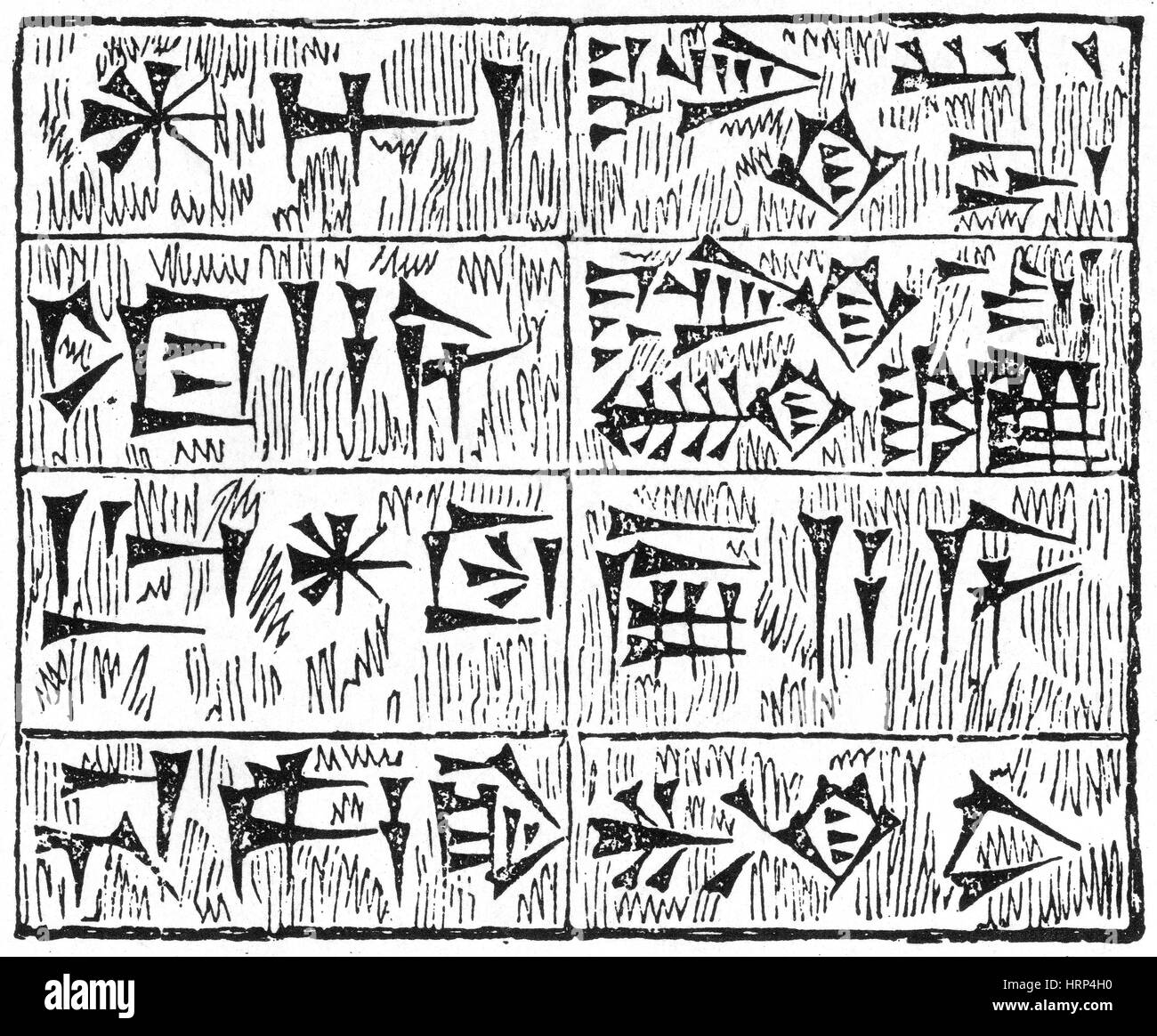 Cuneiform Characters Stock Photohttps://www.alamy.com/image-license-details/?v=1https://www.alamy.com/stock-photo-cuneiform-characters-135096220.html
Cuneiform Characters Stock Photohttps://www.alamy.com/image-license-details/?v=1https://www.alamy.com/stock-photo-cuneiform-characters-135096220.htmlRMHRP4H0–Cuneiform Characters
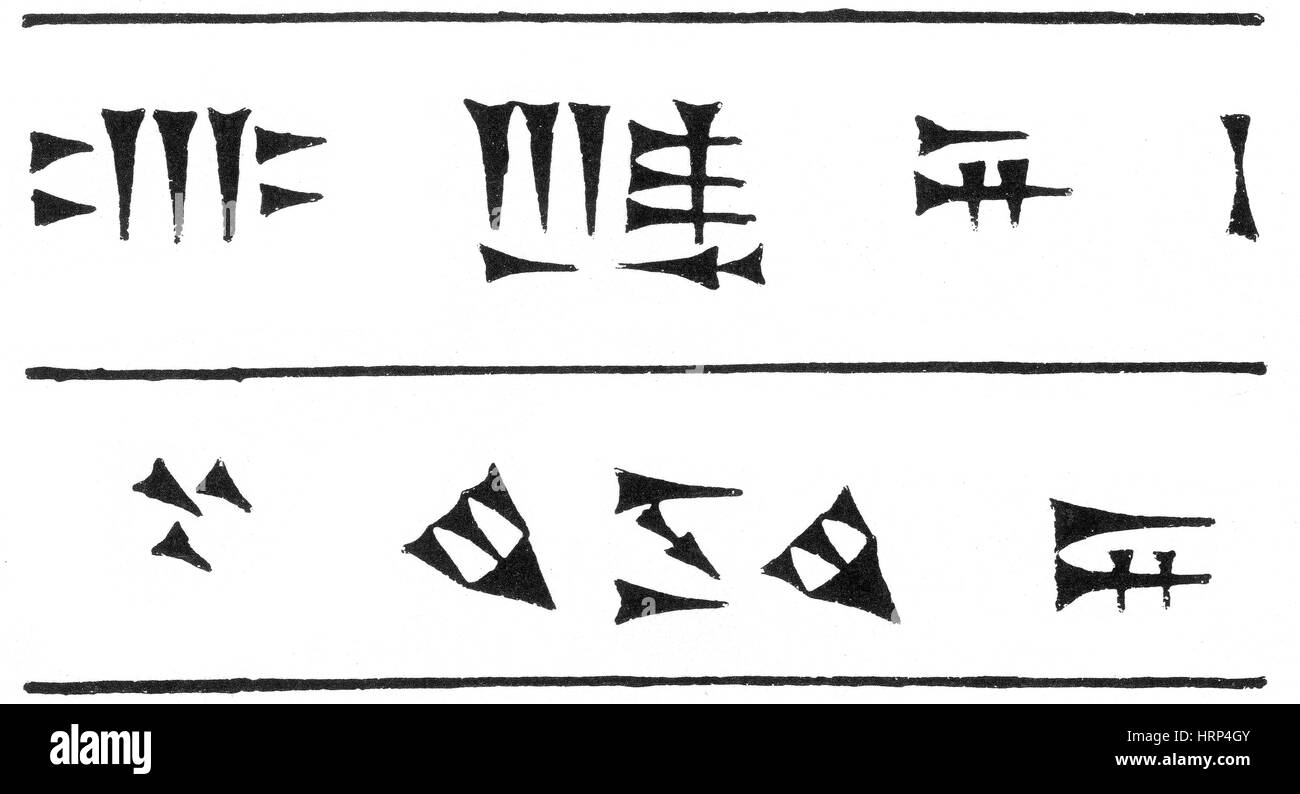 Assyrian Cuneiform Characters Stock Photohttps://www.alamy.com/image-license-details/?v=1https://www.alamy.com/stock-photo-assyrian-cuneiform-characters-135096219.html
Assyrian Cuneiform Characters Stock Photohttps://www.alamy.com/image-license-details/?v=1https://www.alamy.com/stock-photo-assyrian-cuneiform-characters-135096219.htmlRMHRP4GY–Assyrian Cuneiform Characters
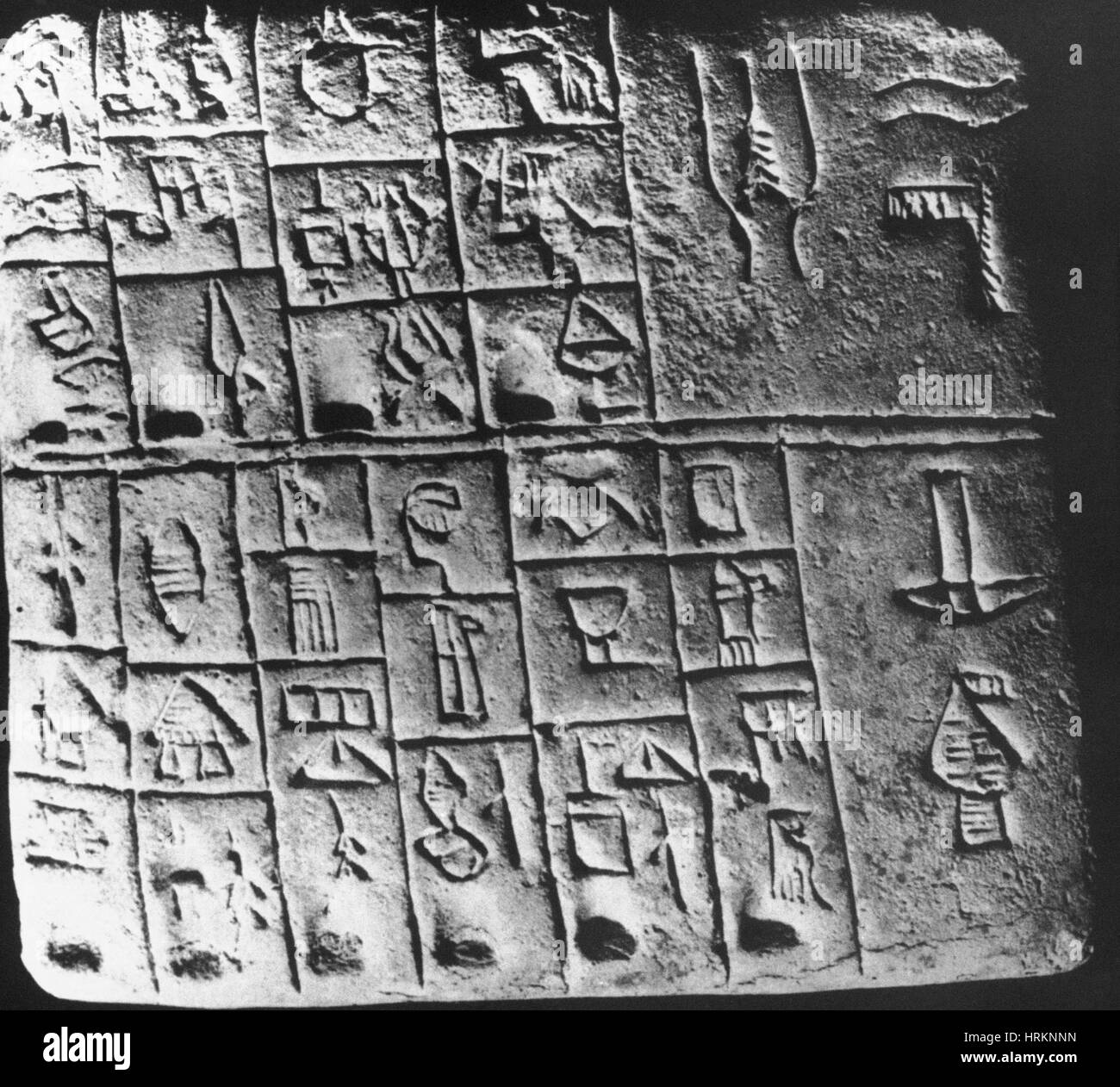 Cuneiform Tablet Stock Photohttps://www.alamy.com/image-license-details/?v=1https://www.alamy.com/stock-photo-cuneiform-tablet-135043825.html
Cuneiform Tablet Stock Photohttps://www.alamy.com/image-license-details/?v=1https://www.alamy.com/stock-photo-cuneiform-tablet-135043825.htmlRMHRKNNN–Cuneiform Tablet
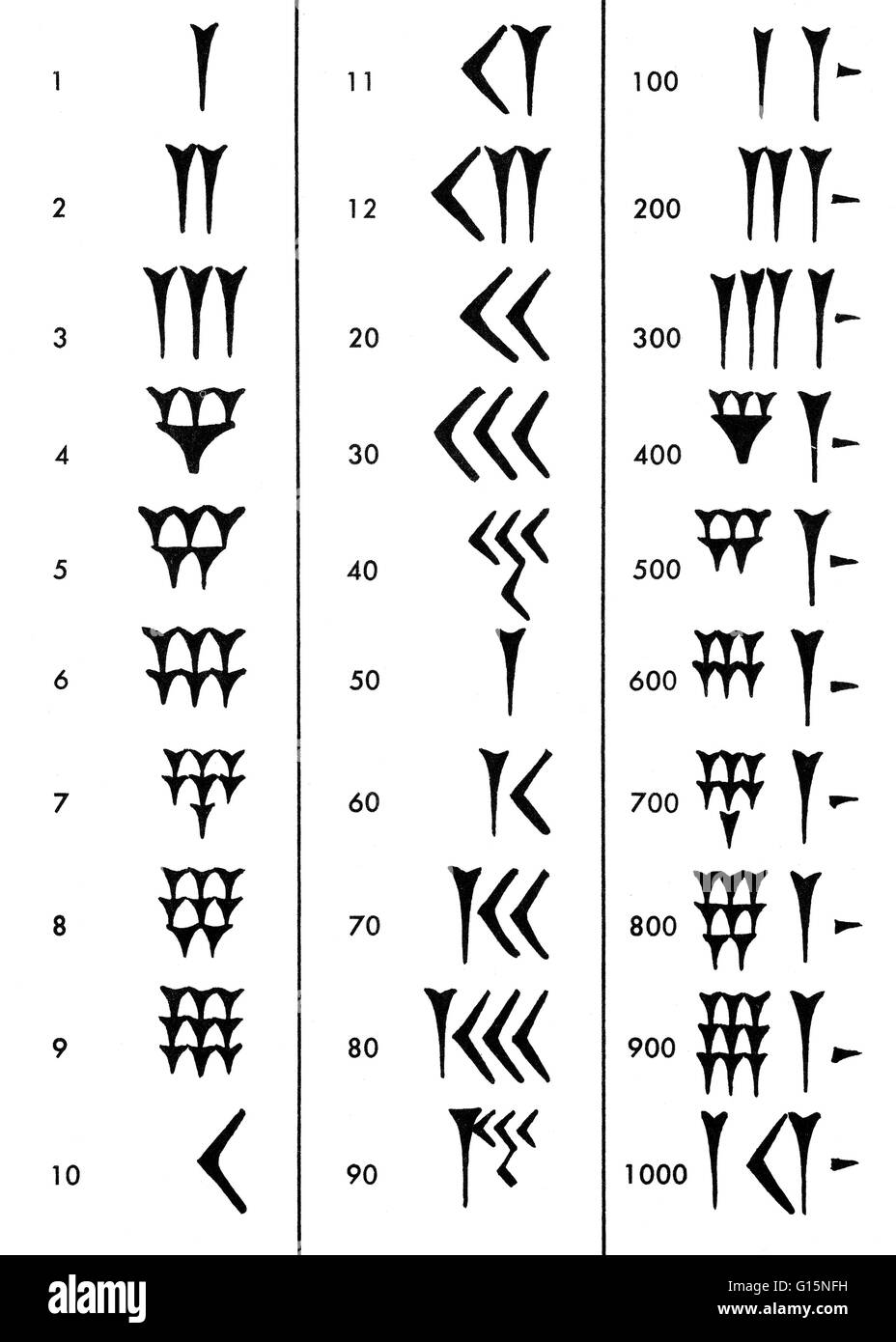 The Sumerians used a numerical system based on 1, 10 and 60. The way of writing a number like 70 would be the sign for 60 and the sign for 10 right after. This way of counting is still used today for measuring time as 60 seconds per minute and 60 minutes Stock Photohttps://www.alamy.com/image-license-details/?v=1https://www.alamy.com/stock-photo-the-sumerians-used-a-numerical-system-based-on-1-10-and-60-the-way-104003525.html
The Sumerians used a numerical system based on 1, 10 and 60. The way of writing a number like 70 would be the sign for 60 and the sign for 10 right after. This way of counting is still used today for measuring time as 60 seconds per minute and 60 minutes Stock Photohttps://www.alamy.com/image-license-details/?v=1https://www.alamy.com/stock-photo-the-sumerians-used-a-numerical-system-based-on-1-10-and-60-the-way-104003525.htmlRMG15NFH–The Sumerians used a numerical system based on 1, 10 and 60. The way of writing a number like 70 would be the sign for 60 and the sign for 10 right after. This way of counting is still used today for measuring time as 60 seconds per minute and 60 minutes
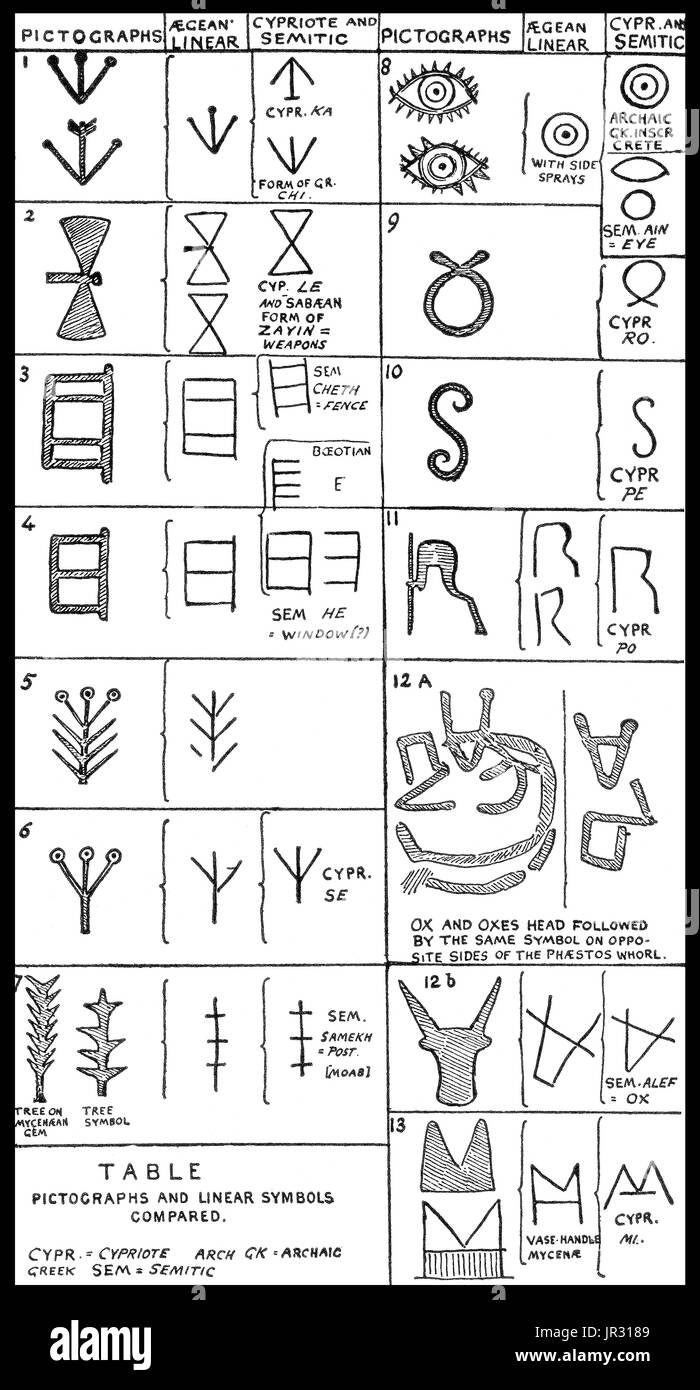 An ideogram or ideograph is a graphic symbol that represents an idea or concept, independent of any particular language, and specific words or phrases. Some ideograms are comprehensible only by familiarity with prior convention; others convey their meaning through pictorial resemblance to a physical object, and thus may also be referred to as pictograms. Pictography is a form of writing which uses representational, pictorial drawings, similarly to cuneiform and, to some extent, hieroglyphic writing, which also uses drawings as phonetic letters or determinative rhymes. Linear A is one of two cu Stock Photohttps://www.alamy.com/image-license-details/?v=1https://www.alamy.com/an-ideogram-or-ideograph-is-a-graphic-symbol-that-represents-an-idea-image151886905.html
An ideogram or ideograph is a graphic symbol that represents an idea or concept, independent of any particular language, and specific words or phrases. Some ideograms are comprehensible only by familiarity with prior convention; others convey their meaning through pictorial resemblance to a physical object, and thus may also be referred to as pictograms. Pictography is a form of writing which uses representational, pictorial drawings, similarly to cuneiform and, to some extent, hieroglyphic writing, which also uses drawings as phonetic letters or determinative rhymes. Linear A is one of two cu Stock Photohttps://www.alamy.com/image-license-details/?v=1https://www.alamy.com/an-ideogram-or-ideograph-is-a-graphic-symbol-that-represents-an-idea-image151886905.htmlRMJR3189–An ideogram or ideograph is a graphic symbol that represents an idea or concept, independent of any particular language, and specific words or phrases. Some ideograms are comprehensible only by familiarity with prior convention; others convey their meaning through pictorial resemblance to a physical object, and thus may also be referred to as pictograms. Pictography is a form of writing which uses representational, pictorial drawings, similarly to cuneiform and, to some extent, hieroglyphic writing, which also uses drawings as phonetic letters or determinative rhymes. Linear A is one of two cu
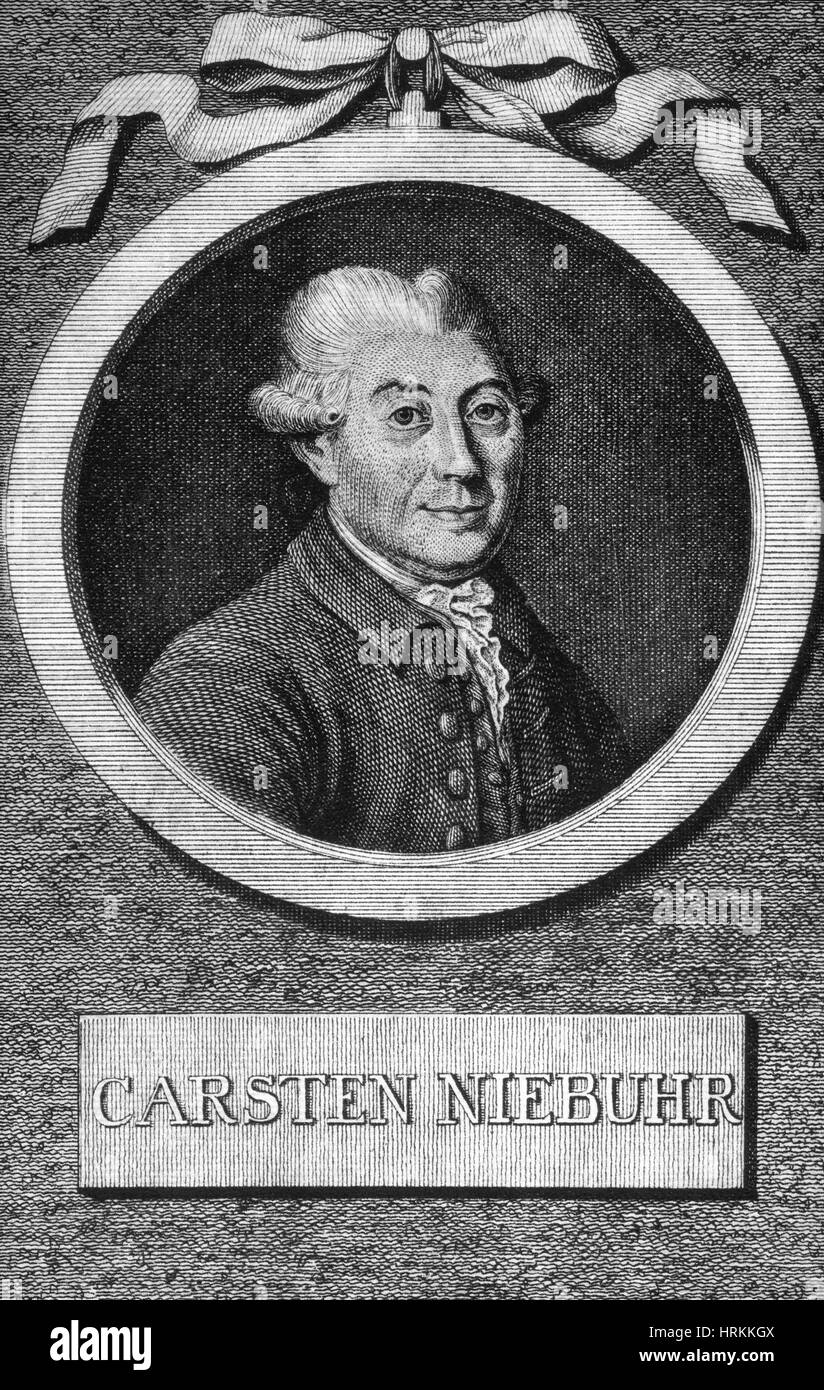 Carsten Niebuhr, American Explorer Stock Photohttps://www.alamy.com/image-license-details/?v=1https://www.alamy.com/stock-photo-carsten-niebuhr-american-explorer-135042122.html
Carsten Niebuhr, American Explorer Stock Photohttps://www.alamy.com/image-license-details/?v=1https://www.alamy.com/stock-photo-carsten-niebuhr-american-explorer-135042122.htmlRMHRKKGX–Carsten Niebuhr, American Explorer
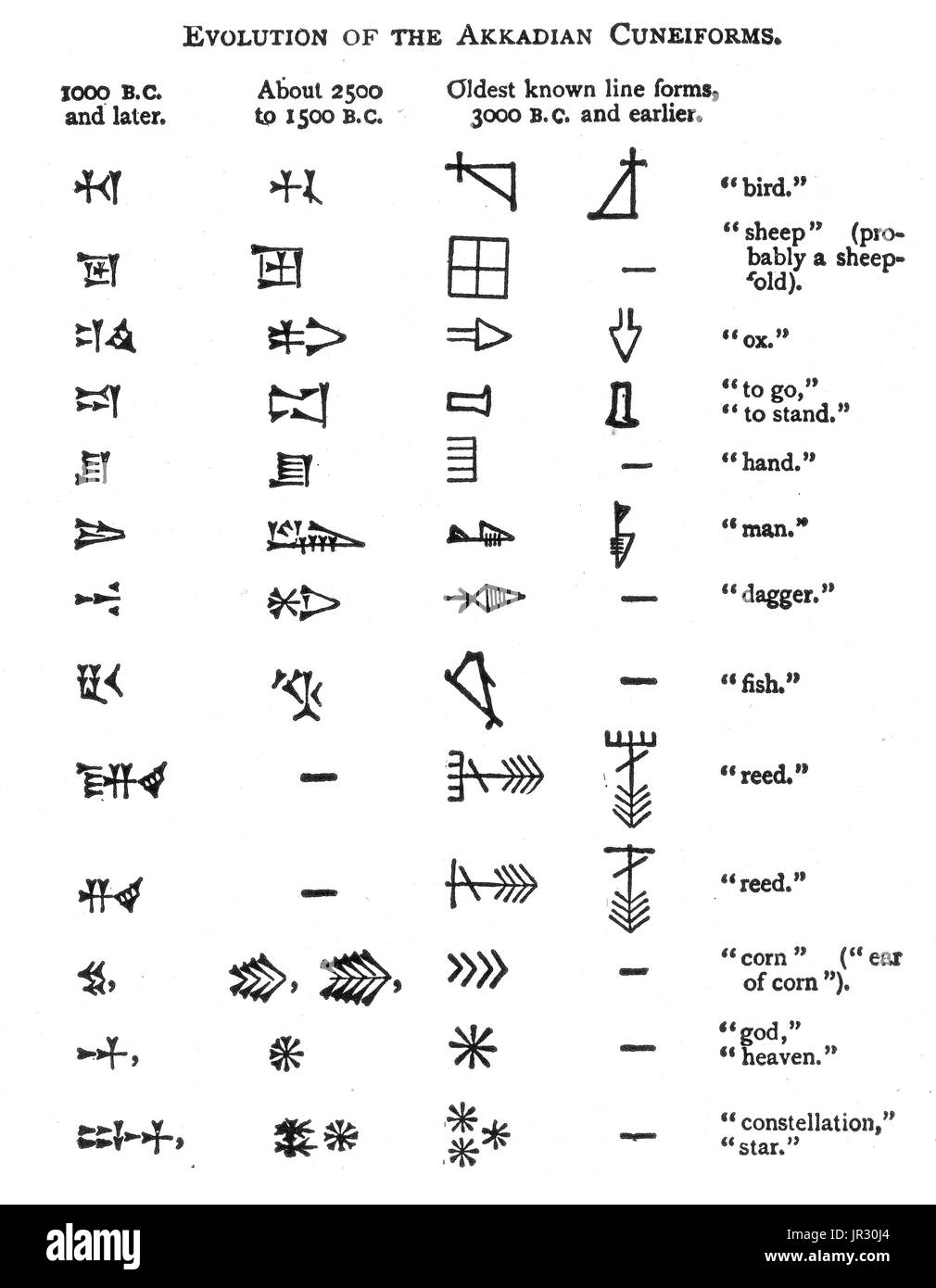 Evolution of Akkadian Cuneiforms Stock Photohttps://www.alamy.com/image-license-details/?v=1https://www.alamy.com/evolution-of-akkadian-cuneiforms-image151886396.html
Evolution of Akkadian Cuneiforms Stock Photohttps://www.alamy.com/image-license-details/?v=1https://www.alamy.com/evolution-of-akkadian-cuneiforms-image151886396.htmlRMJR30J4–Evolution of Akkadian Cuneiforms
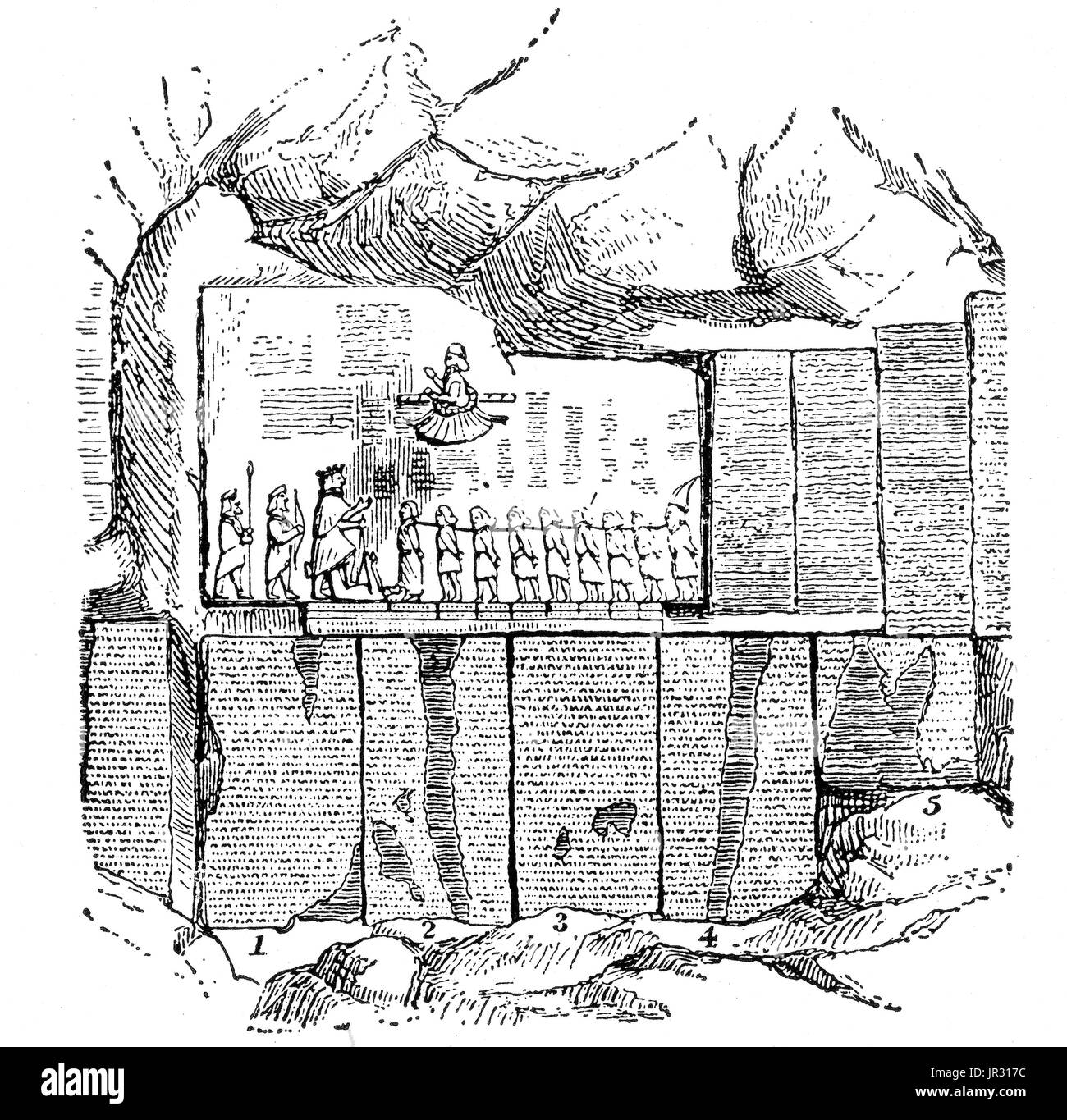 The Behistun Inscription is a multilingual inscription and large rock relief on a cliff at Mount Behistun in the Kermanshah Province of Iran, near the city of Kermanshah in western Iran. Authored by Darius the Great sometime between 522 BC and 486 BC, the inscription begins with a brief autobiography of Darius, including his ancestry and lineage. Later in the inscription, Darius provides a lengthy sequence of events following the deaths of Cyrus the Great and Cambyses II in which he fought nineteen battles in a period of one year to put down multiple rebellions throughout the Persian Empire. D Stock Photohttps://www.alamy.com/image-license-details/?v=1https://www.alamy.com/the-behistun-inscription-is-a-multilingual-inscription-and-large-rock-image151886880.html
The Behistun Inscription is a multilingual inscription and large rock relief on a cliff at Mount Behistun in the Kermanshah Province of Iran, near the city of Kermanshah in western Iran. Authored by Darius the Great sometime between 522 BC and 486 BC, the inscription begins with a brief autobiography of Darius, including his ancestry and lineage. Later in the inscription, Darius provides a lengthy sequence of events following the deaths of Cyrus the Great and Cambyses II in which he fought nineteen battles in a period of one year to put down multiple rebellions throughout the Persian Empire. D Stock Photohttps://www.alamy.com/image-license-details/?v=1https://www.alamy.com/the-behistun-inscription-is-a-multilingual-inscription-and-large-rock-image151886880.htmlRMJR317C–The Behistun Inscription is a multilingual inscription and large rock relief on a cliff at Mount Behistun in the Kermanshah Province of Iran, near the city of Kermanshah in western Iran. Authored by Darius the Great sometime between 522 BC and 486 BC, the inscription begins with a brief autobiography of Darius, including his ancestry and lineage. Later in the inscription, Darius provides a lengthy sequence of events following the deaths of Cyrus the Great and Cambyses II in which he fought nineteen battles in a period of one year to put down multiple rebellions throughout the Persian Empire. D
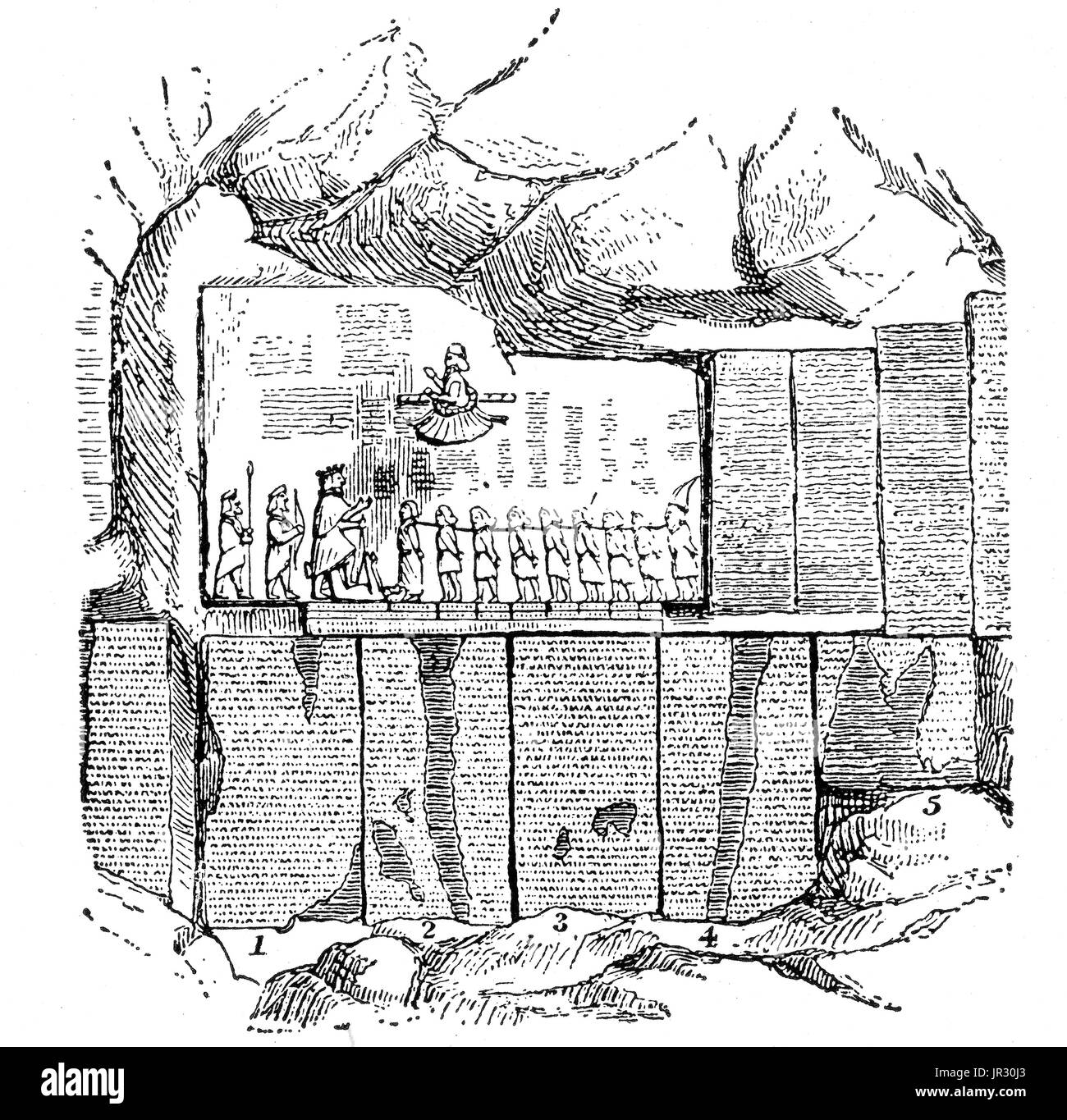 Darius the Great,Behistun Inscription Stock Photohttps://www.alamy.com/image-license-details/?v=1https://www.alamy.com/darius-the-greatbehistun-inscription-image151886395.html
Darius the Great,Behistun Inscription Stock Photohttps://www.alamy.com/image-license-details/?v=1https://www.alamy.com/darius-the-greatbehistun-inscription-image151886395.htmlRMJR30J3–Darius the Great,Behistun Inscription
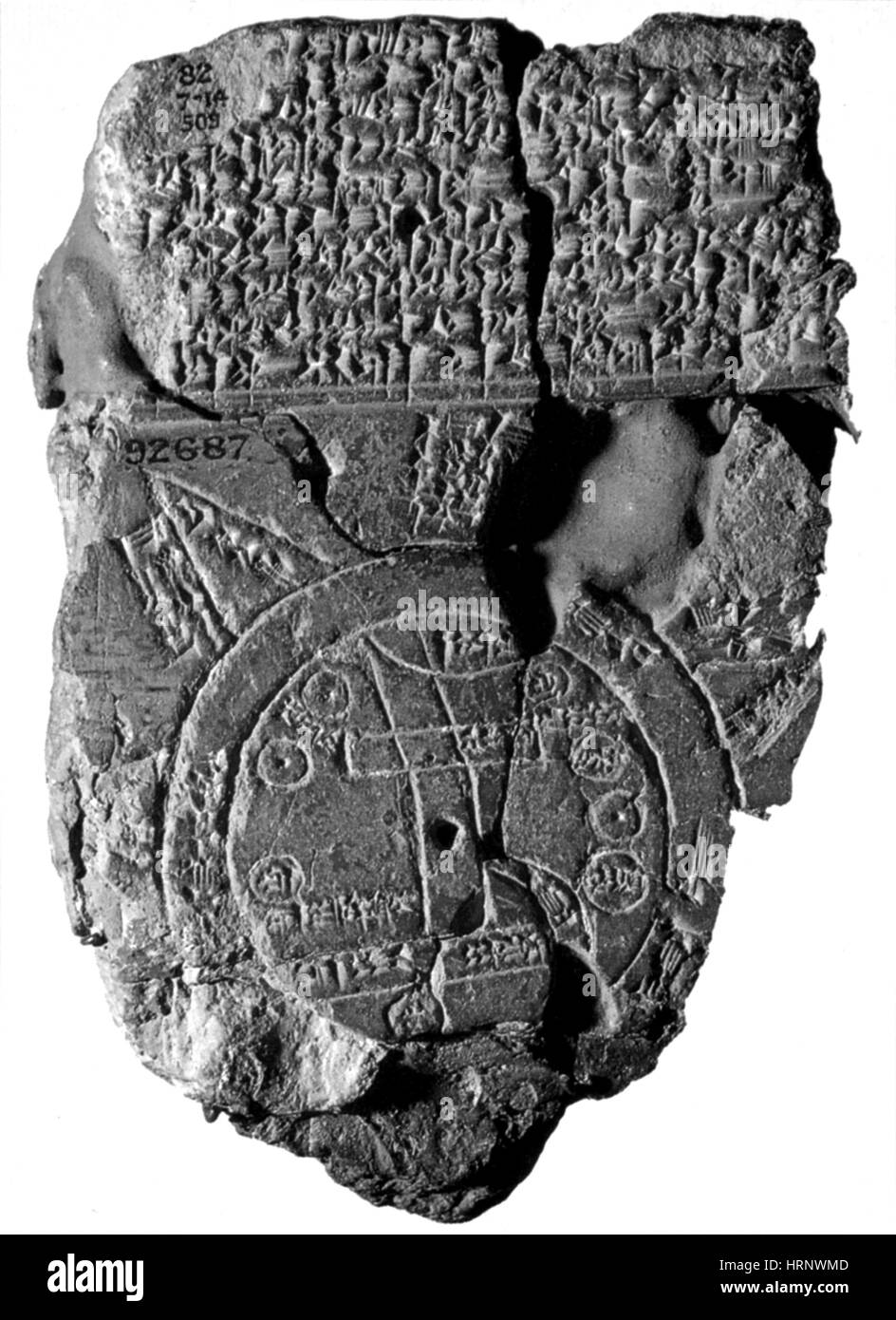 Babylonian World Map, 5th Century BC Stock Photohttps://www.alamy.com/image-license-details/?v=1https://www.alamy.com/stock-photo-babylonian-world-map-5th-century-bc-135090829.html
Babylonian World Map, 5th Century BC Stock Photohttps://www.alamy.com/image-license-details/?v=1https://www.alamy.com/stock-photo-babylonian-world-map-5th-century-bc-135090829.htmlRMHRNWMD–Babylonian World Map, 5th Century BC
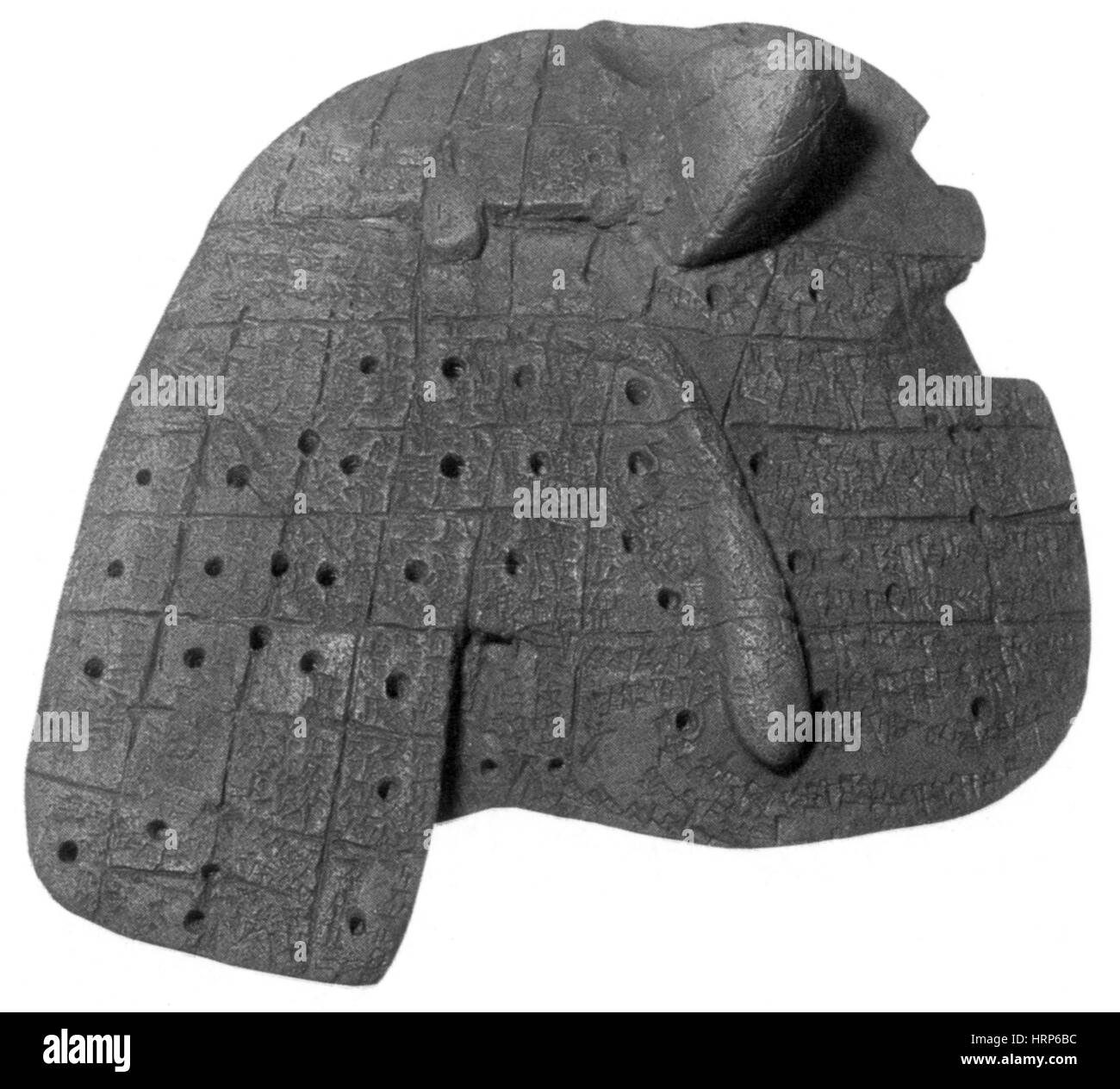 Hepatoscopy, Babylonian Divination, 1900-1600 BC Stock Photohttps://www.alamy.com/image-license-details/?v=1https://www.alamy.com/stock-photo-hepatoscopy-babylonian-divination-1900-1600-bc-135097632.html
Hepatoscopy, Babylonian Divination, 1900-1600 BC Stock Photohttps://www.alamy.com/image-license-details/?v=1https://www.alamy.com/stock-photo-hepatoscopy-babylonian-divination-1900-1600-bc-135097632.htmlRMHRP6BC–Hepatoscopy, Babylonian Divination, 1900-1600 BC
